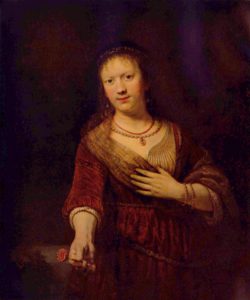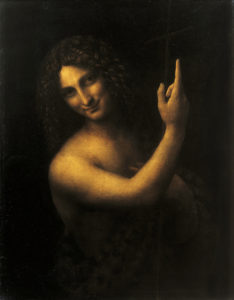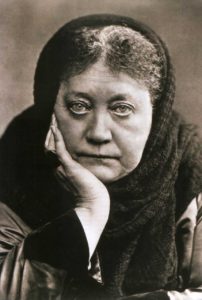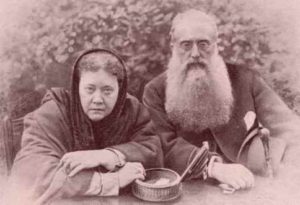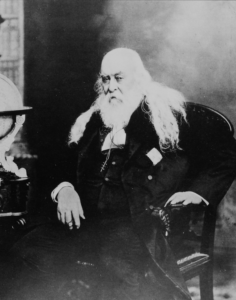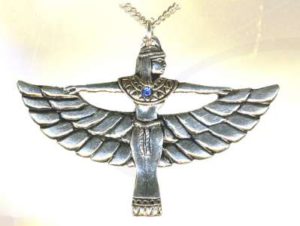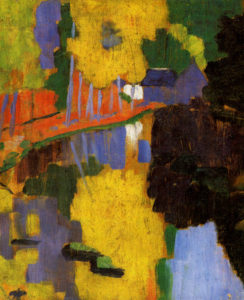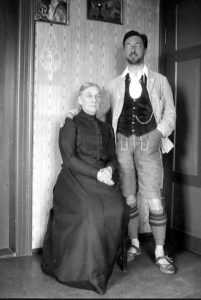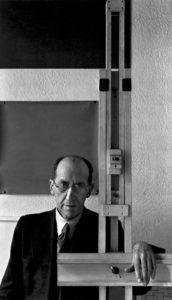Étiquette : Blavatsky
On the origins of Modern Art, the problem of Symbolism


“At the turn of this century, painting is in bad shape. And for those who love the fatherland of paintings, very soon there will only remain the closed spaces of museums, in the same way there remains parcs for the amateurs of nature, to cultivate the nostalgia of that what doesn’t exist any longer…”
Jean Clair, Harvard graduate, director of the Musée Picasso
and of the centenary of the Venice Biennale of Contemporary Art in 1995.
Karel Vereycken, April 1998
Something is fairly rotten in the kingdom of Art, and if today (1998), finally some kind of debate breaks out, it is, halas, for quite bad reasons. Since it is uniquely in the context of budget cuts imposed on Europe by the Maastricht treaty that some questions are raised to challenge public opinion on a question carefully avoided till now: can we go on indefinitely subsidizing “modern artistic creation”, or what pretends to be so, with the tax-payers money, without any demand and outside any criteria?
Abusively legitimated by its status as a victim of the totalitarian regimes of Hitler, Stalin and Mao, Modern Art’s value as an act of resistance to totalitarianism watered away with the collapse of these regimes.
While we oppose the current budgetary cuts, since it would finish off the sick patient, we nevertheless propose to examine truthfully the illness and the potential remedies to be administered.
In France, the slightest critique immediately provoked the traditional hysterical fits. Raising a question, formulating an interrogation or even simply expressing a doubt on the holiness of Modern Art continues to be considered tantamount to starting an Inquisition. Even well integrated critiques such as the « left » leaning author Jean Baudrillard, or the director of the Paris Picasso museum Jean Clair and even the modern painter Ben, immediately bombarded by acid counter-attacks from the french and international Art nomenclature, accusing them of being “reactionaries”, “obscurantist” and, to crown it all, of being “fascists”, “nazis” and even “anti-Semites”.
For seasoned observers these attacks remind the simplicity of Stalinist rhetoric: “Anybody discussing the revolution is a fascist”. Modernist musical composer Pierre Boulez even accused a journalist of being a “Vichy collaborator” because unconvinced of the utility of the computers of his musical research foundation IRCAM.
That spark of debate, if any, became rapidly poisoned by the possessive defense of the scarce budget allocations. Why all this noise? Jean Clair already exposed his views fourteen years ago in his book “Considérations sur l’Etat des Beaux-Arts, Critique de la Modernité” (1983) without provoking such a hullabaloo.
But in times of crisis, funds seem to provoke more passion than fundamentals. In any case, we welcome Clair’s courage. His ironical critique of the rampant snobbism of the tiny, incestuous world of contemporary Art makers is totally uncompromising. His defense of the necessary rebirth of the basic skills of drawing and pastel is on the mark.
Clair rightly makes a distinction between « Contemporary » art on one side and « Modern » art on the other side. Contemporary Art, broke with Modern Art from the point it became a systemic apology of “non-sense [absence of meaning] that was elected a system. » Reality, writes Clair, leads him to demand that we return to “meaning” (deliberately banned by « contempory » art) which was the very power of « Modern » Art.
To understand this difference, inspired by the insights and works of my friend, american art historian Michael Gibson, we shall document here that the birth of « Modern » art was nothing but a mutation from figaritive « Symbolism » to non-figurative (abstract) Symbolism, both accepting their role of expressing a symbolic meaning. « Contemporary art », profiting from the confusion of the idea of a « secret » meaning inherent in symbolic artistry, then sneaked in and tried to pretend that any sort of meaning should and could be eliminated from artistic expression.
QUESTION:
« So if I understood you correctly, you claim there exist criteria that are universal, enabling rational man to distinguish with reason between beauty and ugliness which would free art from the arbitrary caprices of taste?”
ANSWER:
« Uh, yes, and even if one cannot establish a catalogue filled with models and instructions enforceable till the end of all times, we firmly think there exists a way of looking at things, a mental attitude which we can prove to have been fruitful since the early cave paintings, as those of Chauvet in southern France dating from 50.000 years B.C., till today. »
To say it differently, there is no such thing as the aesthetics of form, but some kind of aesthetics of the soul.
Any attempt to frame aesthetics, as a set of formal rules of the visible forms is the shortest road to finish in a sterile academic dead end.
By analogy, we could say that such an attempt in the domain of language would make linguistics the science of poetry…
Leonardo da Vinci defined the mission of the painter as the one who has to « make visible the invisible ». So it is up to us to define the aesthetics of the invisible and how they manifest themselves in the visible realm.
How to represent the world
Let’s look at ways of representing phenomena by starting from what appears to be the « most simple ».
A. “Bounded objects” of an inorganic or organic nature: for example stones, a glass bottle, but also a flower or the body of an animal or a man. Their relative finiteness makes their representation easier. But to “make them alive”, one has to show their participation to something infinite: the infinite variations of the color or a stone, the numerous reflections of light shattered by the glass bottle, the relative infinite number of leaves of a tree, the huge number of successive gestures which dictate spirit and life to the bodies of living beings. As you can see now, these so-called “simple” phenomena oblige us to choose, beyond simple sense perception, perceptions that enable us to express the idea of the object rather than its mere form.
B. “Openly unbounded objects”: for example a wave of the ocean, a forest, the clouds in the sky, or the expression of the eyes of a human being. Even more than in A., the Chinese principle of the “li” has to be considered. Instead of imitating their exterior form, and since their sometimes turbulent shapes escape in any case from our limited sense-perceptions, the exterior form has to be regarded as the expression of the idea that was the generating principle and we have to concentrate on choosing elements in the visible realm that indicate that “higher reality”. That makes the difference between the portrait of a living being and the portrait of a wax model…
C. “Ideas free from an object”: for example Love, Justice, Fidelity, Laziness, Cold, etc. How can we build gangways to the visible capable of representing these “higher ideas”?
ANSWER:
- Instead of representing the idea, I can try to substitute it with the object of the idea (one of Plato’s favorite subjects). For example I can try to represent the idea of Love by representing a woman. However, she cannot be but the object or the subject of love (She is loved or loves), but she is not Love itself.
- Since I’m in trouble having a representation in the visible realm of an idea of a “superior” nature, I decide to designate it by symbol. For example, a little heart to symbolize Love. For a Martian visiting Earth in the context of interplanetary tourism, the little heart has no meaning. By logical deduction, he could arrive at the conclusion the heart indicates heart patients, or cardiologists or eventually the designed victims of an Aztec sacrificial cult. In order to understand what is involved, some earthling has to initiate him into the pre-convened meaning of the symbol to which the inhabitants of earth agreed to. If not, it might take some time before he understands the “secret” meaning of the symbol.
- That symbol can be a simple visible element but also a little story we call allegorical. Illustrating an allegory will always remain a simple didactical exercise far underneath the sublime mission of art.
- The notion of a parable, as those one finds in the Bible, brings us closer to the wanted solution by its metaphorical character (Meta-poros in Greek meaning: that which carries beyond). The isochronical presence of several paradoxes, provoking surprise and irony by the ambiguities of the painting shakes up the sense certainty of our empirical perceptions that darken so much our natural predisposition for beauty.
SYMBOL and METAPHOR, What’s the difference?
Symbol: designates a thing
Metaphor: carries beyond the thing
Symbol: its only value is expressed by itself
Metaphor: its only value is given to it by implicit analogy.
Symbol: its secret meaning can only be learnt by convention
Metaphor: its meaning can be discovered by sovereign cognition.
Rembrandt’s Saskia

Let us examine together Rembrandt’s painting “Saskia as Flora” (1641), where she offers a flower to the viewer. Is this a portrait of Rembrandt’s wife along with the portrait of a flower? Or is there a new concept involved that arises in our mind as a result of this juxtaposition that could be called Love or Fidelity (to you I offer my beauty, as I offer you this flower…) The putting into visual analogy of two quite different things make appear a third one, which is in fact the real subject.
The easiest example of a real metaphorical paradox can be seen at work in wordplay or a cartoon drawing. For example if I draw a young couple in love and replace the head of the young man with the head of a dog, a completely different meaning is given to the image. The viewer, intrigued by the love relationship is surprised by the possessive (or submissive) character suggested by the dog head. Variations of the type of dog and his expression will vary the very meaning of the image. Once again, it is by the use of an implicit analogy that an unexpected arrangement gives us the means to grapple an idea beyond the object represented.
The little light bulb that goes on in our heads when we solve a metaphorical paradox gives us a threefold happiness. First the joy to think, since our thought process is precisely based on that unique process. Second to live in harmony with our world, which being a creative process itself “condemns” us to be free. And finally the joy that derives from the sharing of that happiness of discovery with other human beings who get even more creative in turn. Hence, every scientific or artistic discovery becomes a ray of light enlightening the path for humanity to go. The glowing enders of yesterday give us the fire to illuminate tomorrow.
But to do so, one cannot represent in a formal way the solution found. One is obliged to recreate the context which obliges the viewer to walk the same road we did till the precise point where he discovers himself the poetical concept.
The science of enigmas of Leonardo da Vinci

Renaissance genius Leonardo da Vinci was a specialist of this kind of « organized » enigmas, conspiracies to have us think. Let’s have a look at his painting “Saint John the Baptist”, his last painting and somehow his last will resuming all the best science of his creative mind. The ambiguous character of the person has been often used as “proof” of Leonardo’s alleged homosexuality.
One can indeed ask the question if represented here we see a man or a woman? The strong muscles of the arms plead for male while the gracious face argues for female. Desperate, our mind asks if this is devil or angel? While one finger points to heaven, similar to Raphael’s Plato in the « School of Athens », the other hand rests on the heart, and in the same time a coquette smile meets intelligent eyes…
Of course, Saint-John the Baptist, patron saint of Florence served as the symbol of a humanist Platonic current that realized the fact that the « little lights » of classical Greece announced the coming of the « great light » of Christianity.
Scholastical Catholicism of those days pretended that anybody living before Christ could be nothing more than a pagan. So what about Saint John the Baptist? The compositional method here employed is not of a symbolical nature, but that of paradoxical metaphor, i.e. build by enigmas that guide us, if we accept the challenge, to reflect in a philosophical way about the nature of mankind: how is it possible we are finite in some parts and infinite in others? That we are mind, life and matter? Of divine and human nature?
That is in some words what we mean by the method of paradoxical metaphors, the only method which gives sense to the word « classic », since conceived in a universal way for all men in the time of all times.
The opposite approach is the symbolist one, officially named after an artistic current that swept over Europe at the end of the XIXth century.
Together with impressionism that capitulated to positivism, symbolism was the mother of Modern Art and its bastard son Contemporary Art.
The symbol, erected as a method of artistic expression, is characteristic of a society that is incapable of change. It celebrates the banishing of the movement of progress but masks that self-denial with the never-ending multiplication of images and objects, always equal to themselves. Symbolism is nothing but the transformation into an object of a strong emotion or a mystical thought. The increase of its effect through incantation, fetishism, repetition, etc., agitating the symbol for its magical value as such, evokes the same obsessive fixation as pornography. As the American thinker Lyndon LaRouche ironically underscored the point:
“the difference between Beethoven (method of metaphor) and Wagner (method of symbolism) is defined by the level at which emotions are provoked in the audience. In the case of Beethoven, the beauty evoked brings us to tears. In the case of Wagner, it is the chairs that get wet…”
From there on, as we will document in due course, the arising of “Modern Art” reveals itself to be nothing more than a mere linear transposition of “figurative” symbolism to “abstract” symbolism.
These terms are obviously empty shells, since all figuration is figurative, and all figuration is the expression of what could be called an “abstract” concept or idea, conscious or not.
So, contrary to Contemporary Art, whose aggressive meaning is that nothing has, can or has the right to have any meaning, Modern Art claims to possess a sense of meaning, but that meaning is mystical-symbolical and hermetic by nature. We are not saying that symbols should be banned from Art, but we cannot but underline that symbolistical though as a compositional method is incompatible with Art’s nature.
Real Art concentrates on communicating a unique human quality, the Sublime, that expresses freedom and not that of a man enslaved either to his sentiments neither to his principles.
Contemporary Art, as all large scale swindles, needs quite some rhetoric and literature to convince it’s public of its pure absolute relativity. It is said that each of us sees it differently; that we all possess our own criteria and that formulating any judgment is by itself already an act of a totalitarian fascist in germ. It is somehow like the thief who accuses his victim of cupidity and lack of brotherly love when the victim refuses to hand over his purse. But if one claims the right to create something without meaning, one equally revindicates the right to no critique, and therefore ends any form of real debate beyond « it gives me a kick » or « no kick ».
That Art, when it is sincere, by claiming it cannot be apprehended by human cognition, defines itself as egoistical and asocial. It cannot but harvest what it sows: indifference.
Before entering two personalities considered being the godfathers of Modern Art, Wassily Kandinsky (1866-1944) and Piet Mondrian (1872-1944), it is necessary to situate the historical context in which they operated. Then we will investigate a high level political operation: the Theosophical Society whose malefic theories exerted great influence on both godfathers of Modern Art.
Symbolism, the final stage of Romanticism
To crush the republican spirit that emerged at the end of the eighteenth century, which saw the American and French revolution, the European oligarchy deployed initially Napoleon Bonaparte.
Then, on the ruins of the Napoleonic wars, they promoted the iron corset of the Holy Alliance and the impotent ideology of regretting: the privilege of the suffering heart. Romanticism, often described as a “movement for the liberation of the me, as a reaction against the regularity of classicism and the rationality of the preceding centuries” became the official culture of the Restoration before being adopted by the Monarchy of July.
Even the talented French poet Baudelaire, prisoner of the zeitgeist stated shamelessly: “What is there more absurd than progress?” or, premonitory:
“Who says romanticism says Modern Art, i.e. intimacy, spirituality, color, aspiration towards the infinite”.
In a way this was the expression of a certain revolt against positivism, a “scientific” materialism which some tried to impose top down and for which the hearts of men were not mobilized.
We are light-years away from the “science for all” approach which radiated Gaspard Monge at the early Ecole Polytechnique, or Lazare Carnot’s “Ode to enthusiasm”. It was the same Holy alliance that forced Carnot into exile and outrooted Monge´s influence at the Ecole, crushing France’s scientific and industrial progress.
In 1871, Louis Pasteur, in a beautiful article “Why France did not find a superior man in the moment of peril” analyzed the dramatic events of those days.
But also Germany was living under a real cultural dictatorship. Prince Metternich, by the Carlsbad decrees forbade any representation of Friedrich Schiller‘s theatre plays. Also, the “sulfurous” poet Heinrich Heine, mocking the Salons of Mme de Stael and all the other nostalgics of the lost glory of the past, became the permanent target of the Holy Alliance’s police operations.
Francesco Goya, who strongly lambasted the massacres of Bonaparte’s Spanish expedition (1810-1814) in his series “The disasters of War”, characterized this particular historic moment in his engraving “The sleep of Reason generates monsters”.
The Great Upheaval
On the economic front, it was only after Abraham Lincoln defeated the British backed pro-slavery Confederacy and the then ensuing industrial buildup (1861-1876), that a little progress was tolerated in Europe.
The oligarchy had to solve the following paradox: How can we counterbalance the rising American power while in the same time prevent the emergence of Republics in Europe, inspired by the American System, on the ruins of the European empires?
What some have called the « Great Upheaval » was nothing less than a profound transformation of daily life in Europe. It was precisely at that time that the Symbolist current got so dominant.

In the “industrial polygon of the Europe of steam” which connected Glasgow, Stockholm, Gdansk, Lodz, Trieste, Florence and Barcelona, it is estimated that of 7 persons from the country side, 1 stayed working the land, another went to the new world or the colonies, and the remaining 5 went working in the cities. The same estimate says that close to 60 million people left Europe. One can imagine the cultural choc for those who quit the magical world of pastoral backwardness.
In that sense, Symbolism was also a means for the oligarchy to deprive these incoming populations from the benefits of urban culture by keeping them in a state of irrationality.
The fear of political takeover by sovereign Nation-States dedicated to industrial and scientific progress was so great that the British Prime Minister, Lord Palmerston (1784-1865), activated through his agent Guiseppe Mazzini (1805-1872), the “Young Europe” movement, uniting most revolutionary currents of those days. Under the auspices of the Foreign Office’s Arab Bureau, the east saw the sudden birth of a whole series of Arab countries, eventually localized on this or that oilfield.
The Theosophical Society

It is in that context that one has to situate the extraordinary offensive of the Theosophical Society (TS), one of these pseudo-religions rising out of the esoterical swamp of the second half of the nineteenth century. It is useful to zoom in on the life of Helena Petrowna Blavatsky (HPB) (1831-1891), the main front figure of the TS.
Granddaughter of the Prussian General Alexis von Rottenstern-Hahn, HPB was born in 1831 in Ukraine.
At the age of sixteen, her parents married her to an old General with the name of Nicéphore Blavatsky, vice-governor ofprovince of Erivan, which she quitted nearly immediately.
In 1848, she meets a Copt with the name of Paulos Metamon and as early as 1851 she turns up in London, where she meets the “spiritualists” and meets the “revolutionary” Mazzini. In 1856 she affiliates with the Young Europe’s Carbonarist association.
Then, she travels across different continents having become a toy in the hands of her British promoters which she refers to as her “Spiritual masters”, as she called one of her controlling agents “Master Morya”.
As soon as 1851 she travels to the US and Mexico, crossing Texas and Louisiana. After numerous trips in the Caucasus, Syria and Lebanon, we find her on November 3, 1867, riding a horse siding Garibaldi. Severely wounded at the battle of Mentana, she’s left for dead.
While recuperating in Paris, she meets a journalist with the name of Michal, and the founder of French spiritism, Allan Kardec. The former claim they discovered and developed HPB’s faculties as a medium. Deployed in that capacity to Cairo, and in the USA, she’s accused of being a fraudster. It is relevant to situate Edgar Allan Poe’s literary production as the effort of the pro American system faction to ridicule the British offensive in favor of esoteric irrationality.
Colonel Henry Steel Olcott
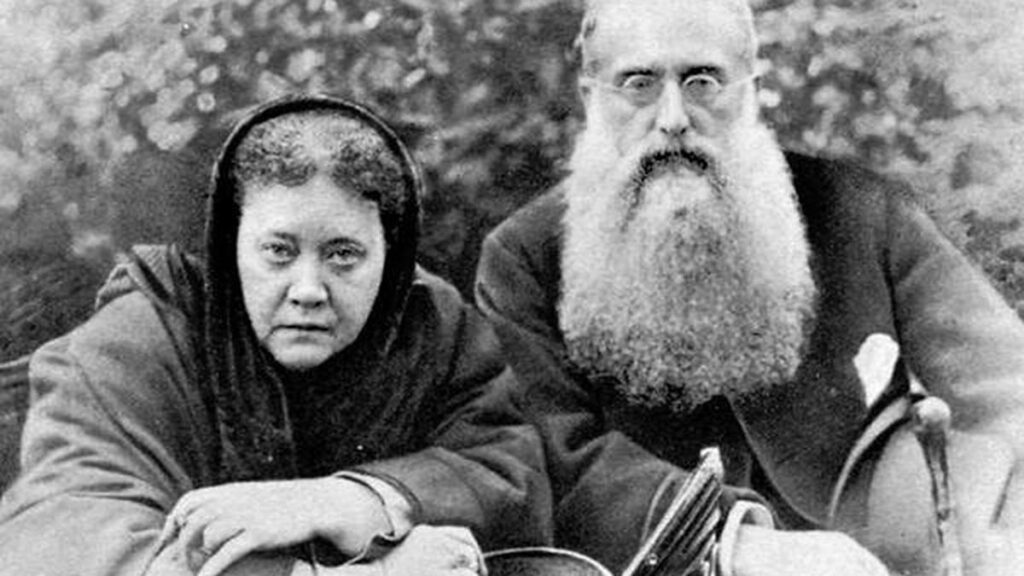
Around 1874, Blavatsky receives the order to enter into contact with a lawyer and insurance expert: Henry Steel Olcott.
Former officer of the Military Police, he became colonel during the civil war and shared his life in between Masonic lodges and spiritism. Active as a journalist, he was in charge of covering paranormal phenomena for the New York Sun and the New York Graphic.

Olcott got many inroads into the American esoterical scene of those days: John King, William Stainton Moses, Leadbeater, the Miracle Club of Philadelphia and a secret society called The Hermetic Brotherhood of Luxor whose members signed their writings with a swastika, symbol of the divinity of Tibet, the immense mountain plateau where supposedly the Aryan race found refuge at the time of the great deluge…
Then, on October 20, 1875 was founded in New York a “Society for Spiritualist investigations”. Its president was Olcott; the two vice-presidents were Felt and Pancoast, while Blavatsky figured as a mere secretary. Without willing to downplay her personal role, it looks she was brought in more for propagandistical reasons than in regard of her proper leadership qualities. As prominent members one can mention William Q. Judge and Charles Sotheran, both high dignitaries of Anglo-American masonry.

It is also remarkable that the Confederate General Albert Pike, Grand Master of the Scottish Rite of the Southern district based in Charleston, and one of the founders of the Ku Klux Klan met Blavatsky in those days, but seems to have dropped her, considering her to low level. Pike’s spiritual reputation is largely overdone and he has been accused of having extensively plagiarized the French occultist Elipha Levi.
Less than a month later, on November 17, 1875, the Society’s named was changed into “Theosophical Society”. Olcott and Blavatsky immediately started a great project to conquer the minds of India.
Officially, they pretended to establish “The Great Contact”, a bridge between the initiated of the East with those of the West and to fusion them together.
HPB gets without any difficulty the American nationality while Olcott obtains from the president of the United States, Rutherford Hayes, a handwritten clearance, a document requesting American diplomats all over the world to provide them their aid. Also, the US Secretary of State provided Olcott a diplomatic passport, something relatively rare for a non-career diplomat. When they reached ground in India, all this American help will give them the means to establish the “British Theosophical Society” (sic).
The British oligarchy seemed to have preferred Hinduism and its great toleration of the cast system where individuals’ desires for a better life are hoped for in the next one, as a preferential partner for the British oligarchy and its imperial class society.
The fundamental choice of the cultural matrix that defines the particular beliefs, transcending any particular form of regime, has always been the “secret weapon” guaranteeing the survival of the oligarchical system. In this way, it is not any longer necessary to police people’s minds on issues, since you control the underlying axioms shaping their thought process itself.
What the Theosophical Society claims today in regard to its role in the birth of a national consciousness of India is an ugly lie, and maybe without Theosophy India might have gained independence a century earlier!
While it is true that Gandhi, who encountered the TS in a vegetarian club in London, studied their works, he never really adopted their convictions. After having started the TS in India, Olcott, in the same geopolitical strategy, will explore Buddhism going through Asia and settle in Japan to wake up the “sleeping masses”.
Olcott composed a Buddhist catechism, created a multicolor Buddhist flag and a General Committee of Buddhist Affairs that functioned as a kind of Vatican for Buddhism. He also held an extraordinary conference in Japan’s military center, Hiroshima. There he distributes swastikas to the audience to which he predicts the coming of terrible wars will strike humanity and that Hiroshima will become one of the symbols for peace and fraternity in the world (sic)!
Swipe Christianity of the Earth!
Olcott and Blavatsky seemed to be quite effective in performing funny magical tricks. Some of them were described by one of their victims, Mme de Jelihowsky:
- Clear and direct answers, of telepathic nature.
- Formulas pronounced in Latin, by way of hits, for remedies which resulted always in healing.
- Divulgation in public of secrets concerning persons that were present but that hurted Blavatsky by their doubts.
- Change of the weight of furniture or persons at will.
- Letters written by unknown correspondents with a writing that was not hers. Often, when somebody asked a question she would say: go in your room, and in such or such a place you will find a letter answering your question.
- Appearance and disappearance of objects without a plausible explanation.
- Faculty to let music be heard at will, wherever and whenever desired.
When depressed, Blavatsky admitted she swindled her admirers.
In their magazine, “The Blue Lotus”, Olcott wrote on November 27, 1895, p. 418:
“Certain days, she was in such a state of mind that she denied the powers by which she had given us carefully controlled demonstrations and pretended to have deceived her public”.
Behind all this cheap mumbo-jumbo reserved for the naïve members of the TS, there was small initiated elite aware of their real geo-strategical imperialism of the mind.
“Our aim”, said Blavatsky, in line with British geopolitics, “is not to restore Hinduism, but to swipe Christianity of the Earth”.
After the cremation of Baron of Palm, a rich donator of the TS, the first one in the history of the United States against which over three thousand people demonstrated, and who’s only aim was to introduce Hinduism to the U.S. population, Olcott and HPB exposed confusedly their doctrine in 1878 in “Isis unveiled”, a 1300 pages book that she called “the work of her life”, available in a more popular version under the name of “The Secret Doctrine”.
From the standpoint of Theosophy (which some called Theosophistry), and in a pure remake of manicheanism, religious beliefs could be classified between male and female religions.
The latter gave preponderance to peace, tranquility, sensuality, fertility and adaptation to the environment, while the male religions gave extensive privilege to the spirit of conquest and undertaking, to proselytism and to the superiority of male virtues.
Of course, Abraham and Moses, founders of the great monotheistic religions in which man does not adapt but intervenes and even discovers his specific harmony by transforming nature and highering its order, were targeted as the animal to be hunted. It was indeed these religions that largely overruled the ancient cult of mother goddess Gaia that became the Isis cult.
Isis cult

ISIS
Isis is the most illustrious of the Egyptian goddesses, in charge of the home, marriage and fertility. Her power spread throughout the universe after she discovered the secret name of the supreme God, Ra.
She embodied the feminine principle, the magical source of all transformation, and was considered by all esotericists to be the Initiatrix, the one who held the secret of life, death and resurrection.
According to legend, she put back together her husband Osiris, whom the serpent Set had cut into fourteen pieces and scattered across Egypt. Only one piece was missing: the penis. Isis made one in silver. Her marriage to Osiris gave birth to Horus, who triumphed in the battle against the evil spirit, Set, but Isis asked him to spare her in order to maintain the cosmic battle between good and evil…
Often designated by the annealed cross, symbol of millions of years of future life, which is confused with the « Isis knot », symbol of immortality, Isis is also represented by the Ouroboros, or the snake that bites its own tail: sexual union with oneself, permanent self-fertilization, perpetual transformation from death to life.
To dominate the battlefield of the mind, a Machiavellian strategy was conceived:
1. Since the adoration of the mother goddess and the practice of female virtues nearly remained exclusively existent in India and Tibet, archaic Hinduism had to be revived. That is the reason why the Theosophists ran to India in order to prevent the nearby extinction of Hinduism. In France, Blavatsky’s main sponsor in that effort was the wealthy Duchesse de Pomar, a Spanish aristocrat descending from the Marquis of Northampton. For that aim, Orientalism and the practice of Yoga had to be encouraged and popularized.
2. Since the TS on its own was too tiny to weaken Christianity, Judaism and Islam, the TS combined its efforts with anti-progress Fabian Socialism. The just battle for republican secularism, founded on the mutual respect of religious freedom was distorted into a virulent denunciation of the Judeo-Christian philosophical outlook. The socialist inspiration of Jean Jaurès, while criticizing the inherent materialism of financial capitalism and Marxism passionately defended, in the name of a sense of transcendence, the right of entire growth and the pursuit of happiness for every human individual.
3. To fight “male supremacy”, it was decided by speech and action to defend anything that supposedly opposed it. Defend universal peace, to fight for the end of sexual discrimination, to make women free from their body, to make love become stronger than violence. For that reason, the TS always took a woman as its front figure. Annie Besant, an attractive Irish protestant and a member of the Fabian Society took the leadership of the TS after having directed the “Malthusian League” of England in 1877.
Such a project obviously didn’t rally much enthusiasm in those days, especially not in Catholic countries. The opposition was so strong that the TS adapted its outlook into some form of esoteric Christianity designed to penetrate the Christian strata. But for HPB, Judeo-Christian monotheism remained nothing else but a barbaric schism of Buddhism:
“What some called with despise paganism was the ancient wisdom full of divinity; and Judaism with its offshoots, Christianity and Islam took all their inspiration of their ethnic father…”
According to HPB, Jesus the Essenian was persecuted by the Jews because “the Essenian were converts, Buddhist missionaries that had come to Egypt, Greece and even Judea”
So, for her, Christianity had to be “de-judaizised” to make it again compatible with the female principle. The basic postulate behind all this was her fascination for the Aryan civilization whose symbol, the Swastika, of notorious nazi reputation, figures still today in the emblem of the ST.

THE SWASTIKA
A widespread symbol in all ancient civilizations (Asia, Central America, Mongolia, India, Northern Europe, Celts, Basques, Etruscans, etc.), it represents the vortex of creation.
The swastika, which often replaces the wheel, is made of a cross, each branch of which is quadrupled, as in vectorial orientations that define a gyratory direction and then return to the center. Its numerical value is therefore four times four = sixteen. This is the powerful development of reality or the Universe, an expression of extreme secular power. Its appropriation by Hitler was no accident.
The rise of the Nazi movement has been associated with the rise of the famous Thule Society, another esoteric society in the theosophical style, in which we find Karl Haushofer, Adolf Hitler’s real master thinker.
The anthroposophists of Rudolf Steiner, a great admirer of Nietzsche and the eugenicist Haeckel, are a dissident branch of the Theosophical Society, omnipresent today among the German « Grünen » (Greens).
The Nabis (the Prophets)
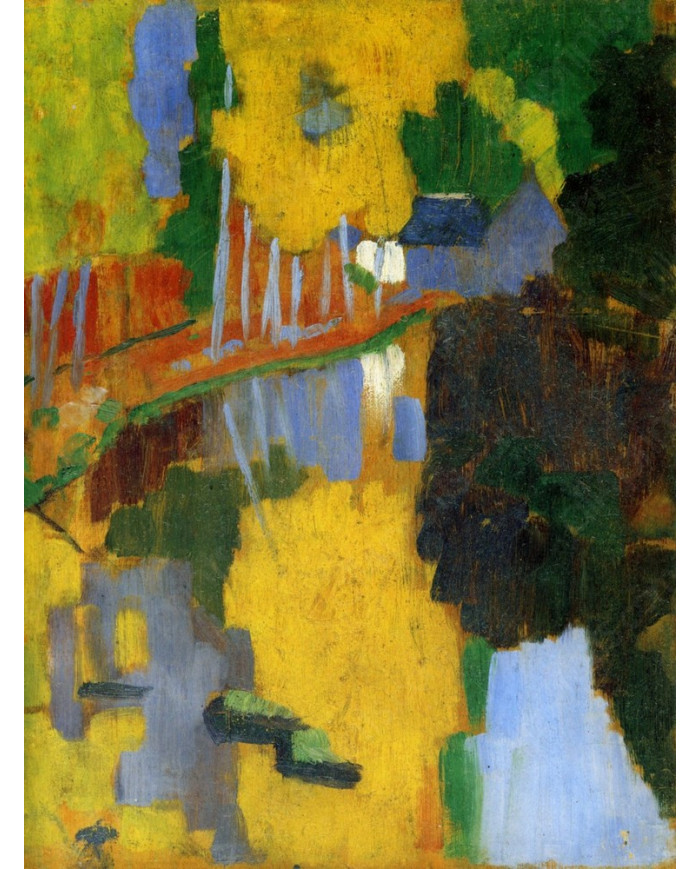
That gives us some elements to situate the historical context into which arrived Modern Art. Esotericism was so much an invading fashion that many painters tried to explore pre-Christian religions to discover “forgotten symbols”.
That was certainly the case of the French symbolist Gustave Moreau when he painted the Gnostic myth of Jupiter and Sémélé. His pupils were the “moderns” Henri Matisse, Georges Rouault and Albert Marquet.
Another young symbolist, Emile Bernard inspired Gauguin, which in turn inspired Paul Sérusier.
Art historian Michael Gibson keenly pointed out the fact that a great number of the founding figures of Modern Art (Kandinsky, Mondrian, Malevitch, Picasso, etc.) have ALL been figurative symbolists at their start.
We are convinced they remained so, but that they deconstructed, i.e. downscaled, the complexity of their symbolic language to more primitive elements of the visual field (a color, a line, a number, a geometry, etc.).
Gibson accurately identified the precise moment of that historical turning point towards modernism with the shift provoked by the group of the “Nabis”.
In 1888, close to Pont-Aven in Brittany France, Paul Sérusier painted one day in the presence of Gauguin a landscape composed of vibrating primitive flat surfaces of colors on the top of his box of cigars.
That work was nicknamed “The Talisman” by his comrades who considered it a revelation of a new approach in painting, the absolute destruction of any reference to physical space by the use of light or perspective. Welcome to the mystical flat space of color and its “interior light”.
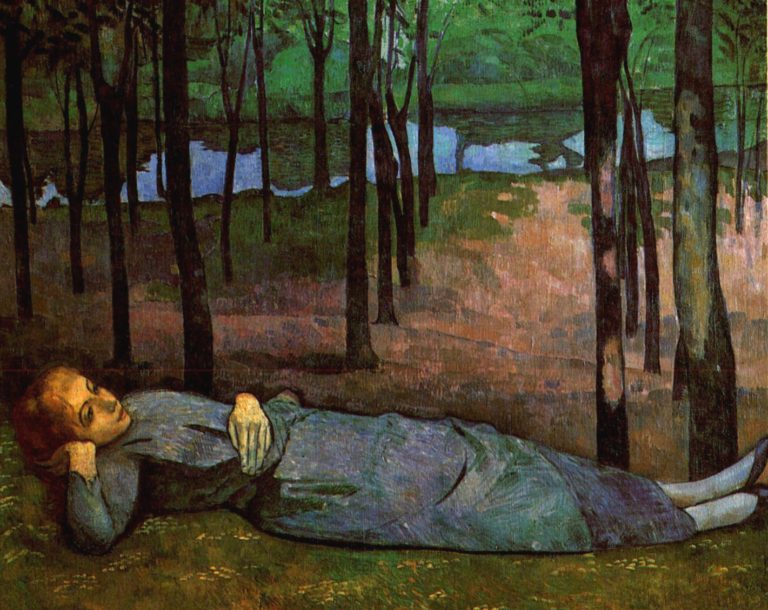
Paul Sérusier, Emile Bernard, Paul Gauguin and some friends rapidly called themselves the “Nabis”, which meant prophets in Hebrew.
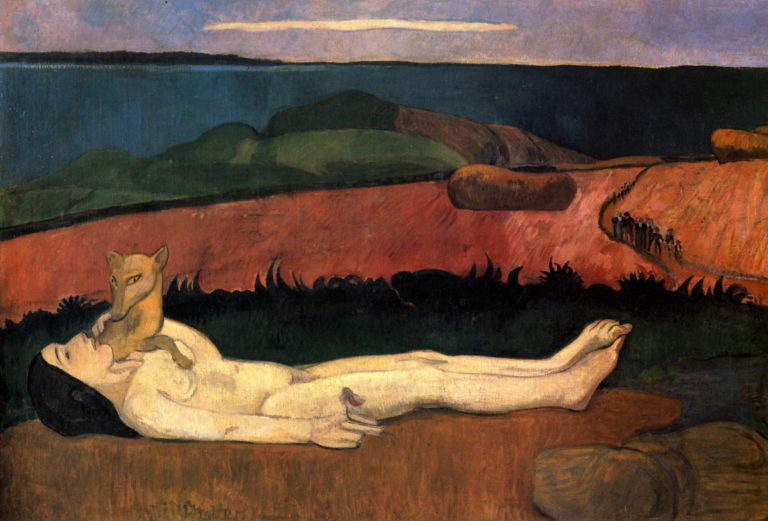
They regularly met in a house they called “The Temple” on 22, Boulevard Montparnasse in Paris. The phrasing alone already indicates the messianic mindset of these converts. Hoaxer Sar Joséphin Péladan united in 1892 all these young talents to the Salon of the Rosicrucians.
In the « Amendments of the Esthetical Rosicrucians », Peladan explicitly prescribed history painting, the painting of patriotic or military scenes and also,
« any representation of contemporary life, portraits, rustic scenes, seascapes, oriental scenes, domestic animals, flowers, fruits, accessories and other exercises painters insolently dare to expose ».
On the contrary « and to privilege the ideal of Catholicism and mysticism, the Rosicrucian order will welcome any work founded on legend, myth, allegory, dream, etc. »
One sees here, how Catholicism, as much as its opponents, if stripped from its content and reduced to its bare symbols could coexist peacefully with these insanities.
One ends up wondering why a World War didn’t break out earlier with elites espousing such follies! And when it did break out in 1914, Jacques Emile Blanche declared,
« Very often during this chemical and scientific ‘cubist’ war, in the night damaged by the air raids, I dreamt about Stravinsky’s Sacre du Printemps ».
Peladan’s Salon brought together symbolists from Belgium, Holland, Germany, such as Ferdinand Hodler, Carlos Swabe, Jan Toorop, Ferdinand Knopff, Jean Delville, Georges Minne and Xavier Mellery, with « Nabis » like Emile Bernard, Félix Valloton and Charles Fillinger.
A great part of this came into France from across the Channel where a real revolt was going on against the Academicism of Sir Joshua Reynolds.
Under the auspices and protection of the very popular John Ruskin, a real nostalgic fanatic willing to bring humanity back to a pre-Renaissance mystical feudal order, appeared the Pre-Raphaelite Brotherhood, the PRB, that one of it’s degenerate founders, Dante Gabriel Rosetta, with sincere self irony called « Penis Rather Better »...
Kandinsky: from positivism to mysticism

The life path of the Russian painter Wassily Kandinsky, universally identified as the official godfather of Modern Art, gives us even more insight in the subject matter.
Kandinsky was born on December 4, 1866 amidst a wealthy orthodox family of aristocrats that made it as tea merchants. As Henri Matisse, he enters the University to study law and political economy.
In 1889 he’s sent on a mission by the Imperial Society of Natural Sciences and Ethnography to study the criminal law of the Finish community, the syrjaenen, a non-christianized tribe living in the province of Vologda, five hundred kilometers north of Moscow.
Kandinsky admitted in 1937:
« To be honest, the origin of my abstract painting has to be looked for in the popular Russian painting which I discovered for the first time during my trip to Northern Russia. »
Obtaining the post of law professor in 1896, another event that takes place the same year will completely “blow” his mind and decide him to quit his academic career entering a profound
mystical crisis.
That event was the discovery of radioactivity by the French physician Antoine-Henri Becquerel:
« For me, the disintegration of the atom, was the same thing as the disintegration of the entire world. The most solid walls suddenly collapsed. Everything became precarious, unstable and floppy. I wouldn’t any longer be astonished to see a stone melt in the air in front of me and become invisible. Science seemed to be annihilated: its most solid bases were a delusion, an error of scientists who were not building in a transfigurated light their work with a solid hand stone by stone, but grappling in the darkness. There, looking for truths by chance, and in their blindness, they confounded one object for the other. »
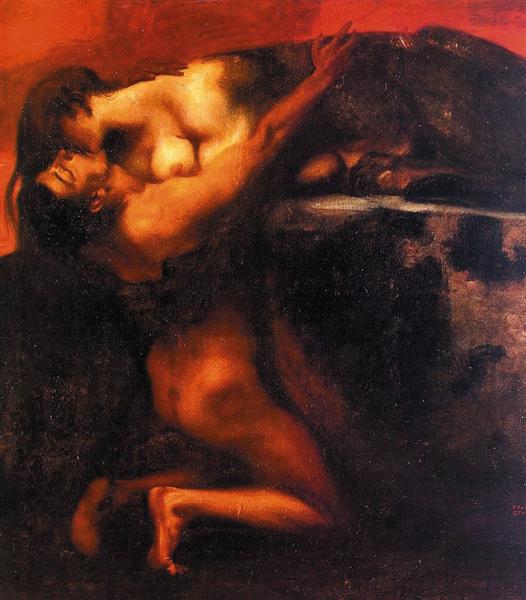
Kandinsky’s transition from “materialistic positivism” to “mystical spiritualism” is a clinical study case of the point we want to demonstrate.
Ecstatic after the discovery of a Wagner opera performance in Moscow, he leaves Russia to go live in Munich. He gives the following description of that experience:
« Lohengrin seemed a perfect realization of Moscow. The violins, the profound bases and particularly the wind instruments personify for me the splendid power of the twilight hours. »
In 1900, after a first refusal, he is admitted, together with Paul Klee, to enter the Academy of Franz von Stück, a well-referenced symbolist of Munich.
Von Stück’s painting, the « Kiss of the Sphinx » takes up the same theme as Moreau’s « Jupiter and Sémélé. » Attracted by (female) beauty, man in reality embraces death (a woman), a remake of the classical Eros/Thanatos theme.
Der Blaue Reiter to defeat materialism
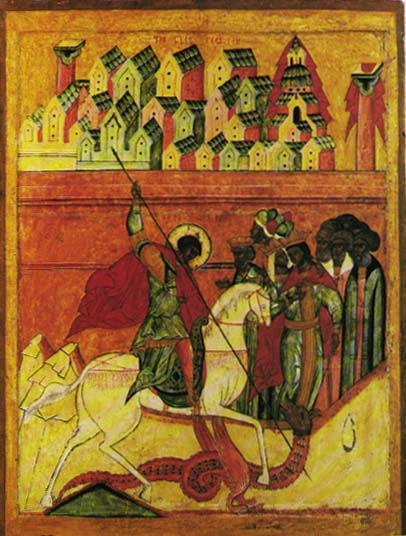

One year later, the pupil becomes himself a teacher and creates the group “Phalanx”, symbol of the fight against Academicism.
Kandinsky reveals himself as an able organizer of art exhibits, throwing in his personal fortune and capable of convincing other sponsors.
Very rapidly he gives the exhibits an international dimension and the presence of foreign artists reinforces the illusion that the new tendency in art possesses a universal character. In the theosophist tradition, he rightly opens his academy to women, excluded till then from art academies!
His admiration for Blavatsky is limitless.
« Blavatsky was certainly the first to establish, after living for years in India, a solid link between these so-called « savages » and our culture. At that point, there came into being one of the greatest spiritual movements uniting a great number of people, materializing that union under the form of a « Theosophical Society ». That society is composed of lodges, who try to approach the questions of the spirit by the way of interior knowledge. »
Uniting the group of « Die Brücke » with his own efforts and those of Franz Marc and Paul Klee, he called into being the almanac of the “Blaue Reiter” (Blue Cavalier), in reality a reworked image of a Byzantine icon of Saint-Georges defeating the dragon of evil transposed into a bleu cavalier defeating materialism.
In his ground text of 1909, Concerning Spiritual in Art and painting in particular, Kandinsky builds up a theoretical system where every color possesses its own separate identity:
« Red, as one imagines oneself, as a color without border, typically warm, acts interiorly as a very living color, vivid and agitated, which does not possess the thoughtless character or yellow that gets dispersed to all sides, but gives the effect, despite all its energy and intensity, of the powerful note of immense force nearly conscious of its aim.
« There is in that effervescence and that eagerness, principally in itself and scarcely turned towards the exterior, some sort of male maturity. »
« When it is medium, as cinnabar, the red gets more permanent and increases its sharp sensibility: it is like a passion that burns with regularity, a force certain of itself, which is not easy to overlay, but which can be extinguished by the blue as red iron by water. That red tolerates nothing cold that makes it lose its resonance and its meaning. Or more exactly, that tragic, brutal cooling down produces a tone that painters, especially today, avoid and outlaw as « dirty ». They are wrong. Dirt, through its material form, represents materially, as a material being, possesses its interior resonance as any other material being. That why the attempt to avoid dirtiness in painting is as unjust and arbitrary as yesterday’s fear in front of « pure » color.
« One does not have to forget that all the means derived from the interior necessity are pure. Said differently, that what is dirty from the outside is pure from the inside. If not, what is pure from the outside is dirty inside. »
« The six colors, who, by couples, form three major contrasts, present themselves to us as a great circle, as a snake which bites its tail (symbol of infinity and eternity). And on the right and on the left we find the two great possibilities for silence; the one of death and the one of birth. »
One sees here the splendid rigor of a law professor, charmed by the “sense of construction of Roman law”, applying his science zealously to mysticism. Kandinsky’s writings are always inhabited with references to music, such as resonance, harmony, rhythm, etc.
In the same way musical ideas got freed of the presence of text and words, Kandinsky and argue that the same thing can be done in the visual domain using merely color, rhythm, form, etc. taken as entities on themselves.
But what music is he talking about, beneath Wagner? In Kandinsky’s immediate entourage we find the atonal composer Arnold Schönberg, who exploded the well-tempered system according to the same mystical principles, making it as such incapable of transmitting ideas.
From Mondrian to Breker
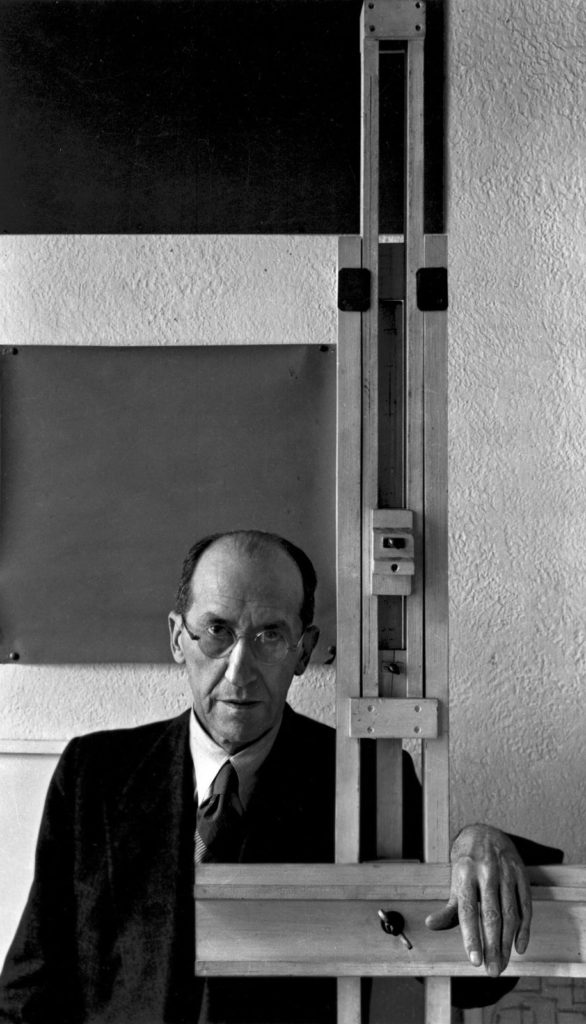
The famous Dutch cubist, Piet Mondrian, was another original product resulting from the mixture of Theosophy and Calvinist rigorism.
At that time, the TS launched a recruitment drive calling on those desiring to “have a place amidst the pioneers of the coming thinking”.
The unique picture decorating the wall of Mondrian’s studio in Laren was a large picture of Blavatsky. The artist was in frequent discussion with the Dutch theosophist writer Schoenmakers whose books Mondrian was distributing.
In 1892, he starts studying Theosophy and joins the TS in 1909.
His triptych, “Evolution” expresses the three stages of spiritual evolution: on the left, the mother goddess with triangles pointing down, the lowest level. In the middle, a female figure, with triangles pointing up, stage of activity and awakening. On the right the synthesis of both, the crossing triangles forming a David star.
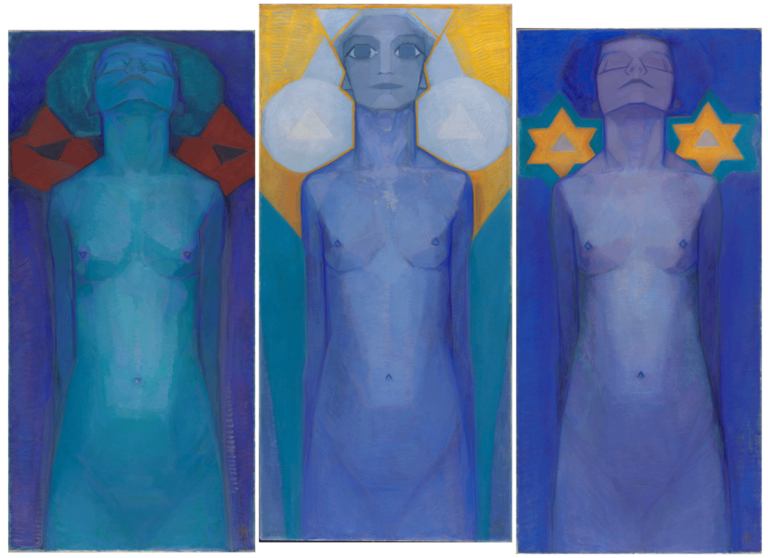
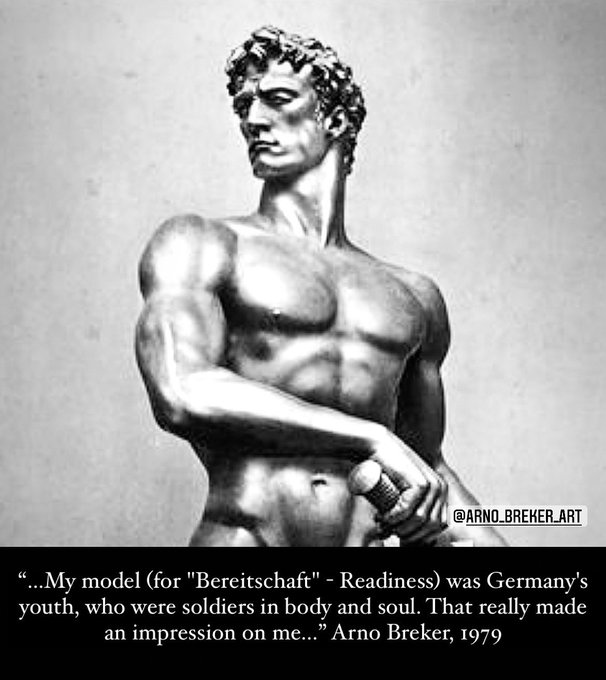
Let us not forget talking about the official art of the Third Reich, with the figurative symbolism of the outright pagan sculptor Arno Breker.
Breker was Hitler’s personal pet sculptor and realized in 1936 the infamous incarnations of the Ubermensch (superior man) for the Nazi’s Olympic Stadium in Berlin.
As proven by interviews after the war, the so-called “apolitical” Breker was very well aware for what kind of power he was working.
His work “Bereitschaft” (readiness) of 1939 proves the case.
Mascot of the Parisian elites, since trained by a Frenchman, his personal exhibit at the Orangerie in Paris in 1942 drew over 80.000 visitors. He shared the fascist ethics of filmmaker Leni Riefenstahl, always ready to popularize nazi symbology.
Breker was befriended with Jean Cocteau, Vlaminck and Derain, and turned down Stalin’s offer to work for the USSR after the war.
A cubist in his early days (1922), he was disappointed by the meeting he had with Paul Klee and the Bauhaus, and invested himself in the total deification of the human body. Breker confirmed: “I always tried to give a meaning with symbols”.
In all his spirituality, Breker did not hesitate in his “Vision of Europe” to transpose an eagle’s heads on human bodies, making them into Horus, son of Isis.
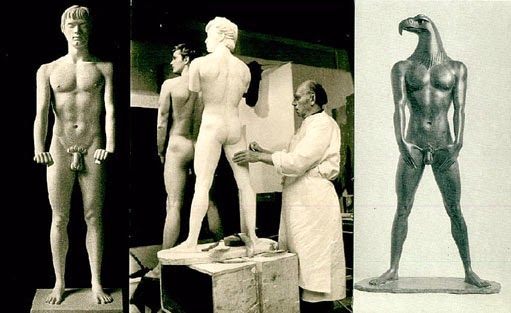
The inversion of these symbolisms, restating the supremacy of male values over female values was nothing less than the creation of esthetics of war.
In 1980, Breker explained in an interview how he saved the life of Picasso and that of Aristide Maillol’s Jewish companion, Dina Vierny using his direct position as an intimate of Adolph Hitler.
The Italian futurists are another obscene example. Many proudly joined the fascist movements and some were really chocked Hitler condemned their modernism at a Nuremberg rally.
Marinetti, who published his “Futurist Manifesto” in Le Figaro in 1909 claimed proudly:
« Point 3: Literature being up till now an apology of contemplating immobility, ecstasy and sleep, we want to exalt the aggressive movement, the fevery insomnia, the gymnastic step, the dangerous jump, the slap in the face and the punching.
« Point 7: There is no beauty outside struggle. There are no masterpieces without aggressive character. Poetry must be a violent assault on unknown forces, to summate them to lie down before man…
« Point 9: We want to glorify war –the unique hygiene of the world, militarism, and patriotism, the destructive gesture of the anarchists, the nice ideas that kill, and the disdain of women…
« Point 10: We want to demolish the Museums and Libraries, fight moralism, feminism and all of opportunistic and utilitarian cowardness. »
As we have demonstrated, this modernism is nothing less than the restoration of the most backward values of ancient civilizations, deprived of their dynamic and reduced to caricatures of their worst defaults.
What we defend here is on the contrary a Renaissance, that is a universal but authentic process of artistic creation fertilized by the best contributions of all cultures, be them Indian, African, Asiatic, American or European.
Our critique of Modernism is not based on any nostalgic longing for a supposedly perfect Golden Age that is no more, but on the commitment to valorize mans dignity and mind.
If you really want to use the word modern, talk about the Mummy portraits of the Fayoum of the second and third century after DC.
Theosophy today
Even if there still exists today an international network of Blavatsky lodges from Antwerp to Philadelphia or Saint Petersburg, it has been in the recent days mainly the radical green current who is leading the fight to destroy the humanist cultural paradigm.
As the Theosophists yesterday, the Greens which have replaced the mother goddess (sounds too religious) with Mother earth (Gaia) express the same messianic zeal in their commitment to sweep the earth and often rally de facto the forces of race, soil and blood.
As yesterday, the green current gets supported by the highest spheres of Anglo-American aristocratic gangsterism.
Deceased financial angel of French archconservative Philippe de Villiers, Jimmy Goldsmith, has a brother, Teddy, who happens to be one of the main funders of Greenpeace!
Documents and articles consulted:
- Chaitkin, Anton, Tarpley, Webster, The Palmerston Zoo, Executive Intelligence Review, Vol. 21, nr.16, Apr.15, 1994.
- Cheminade, Jacques, Time to destroy the myth of Napoleon Bonaparte, Executive Intelligence Review, Vol. 23, 42, Oct.18, 1996.
- Clair, Jean, Considérations sur l’Etat des Beaux Arts – Critique de la Modernité, Gallimard, Paris 1983.
- Gibson, Michael, Le Symbolisme, Editions Taschen, Paris, 1994.
- Kandinsky, Nina, Kandinsky et moi, Flammarion, Paris 1978.
- Kandinsky, Wassily, Concerning the Spiritual in Art, and painting in particular, Dover Editions, New York, 1977.
- Lantier, Jacques, La Théosophie, Editions Culture, Art, Loisirs, Paris.
- LaRouche, Lyndon, How Cauchy ruined France, EIR, Vol.24, nr. 24, June 20, 1997.
- Noël, Bernard, Arno Breker et l’Art officiel, Jacques Damase Editeur, Paris 1981.
- Prampolino, Enrico, Stile Futuristica, nr. 3, Turin 1933.
- Parmelin, Hélène, Peinture, pierre de touche de la liberté, L’Unité nr. 416, 1978.
Index, Études Renaissance

INDEX, Etudes Renaissance
- Mohenjo-Daro, Harappa: Le défi que nous lance la modernité de la Civilisation de l’Indus (FR en ligne);
- Mohenjo-Daro, Harappa : The challenging modernity of the Indus Valley Civilization (EN online);
- La Route de la soie maritime, une histoire de 1001 coopérations (FR en ligne)
- The Maritime Silk Road, a History of 1001 cooperations (EN online);
- Afghanistan, le pays des 1000 cités d’or et l’histoire d’Aï Khanoum (FR en ligne);
- Afghanistan: the Land of a 1000 Golden Cities and Aï-Khanoun (EN online);
- Le miracle du Gandhara, quand Bouddha s’est fait homme (FR en ligne);
- The miracle of Gandhara: when Buddha turned himself into man (EN online);
- Derrière les chevaux célestes chinois, la science terrestre (FR en ligne);
- The Earthly Science behind China’s Heavenly Horses (EN online);
- Et l’Homme créa l’acier… (FR en ligne);
- Portraits du Fayoum: un regard de l’au-delà (FR en ligne) + EN pdf (Fidelio);
- ARTKAREL LOUVRE AUDIO GUIDE: The Greek tradition behind the Fayum Mummy Portraits (EN audio);
- La pratique ancestrale d’annulation des dettes (FR en ligne);
- The Ancient Practice of Debt Cancelation (EN online);
- Bagdad, Damas, Cordoue, creuset d’une civilisation universelle (FR online);
- Mutazilisme et astronomie arabe, deux étoiles brillantes au firmament de la civilisation (FR en ligne). (EN online version);
- Qanâts perses et Civilisation des eaux cachées (FR en ligne). (EN online version).
- Renaissance africaine: la splendeurs des royaumes d’Ifè et du Bénin (FR en ligne) + (EN online);
- Sur la peinture chinoise et son influence en Occident (FR en ligne) + EN pdf (Fidelio).
- L’invention de la perspective FR pdf (Fusion) + EN pdf (Fidelio);
- La révolution du grec ancien, Platon et la Renaissance (FR en ligne)
- The Greek language project, Plato and the Renaissance (EN online).
- Les Frères de la vie commune et la Renaissance du nord (FR en ligne)
- Moderne Devotie en Broeders van het Gemene Leven, bakermat van het humanisme (NL online)
- Devotio Moderna, Brothers of the Common Life, the cradle of humanism in the North (EN online)
- 1405: l’amiral Zheng et les expéditions maritimes chinoises (FR en ligne)
- Jan van Eyck, la beauté comme prégustation de la sagesse divine (FR en ligne) + EN on line.
- Jan Van Eyck, un peintre flamand dans l’optique arabe (FR en ligne)
- Jan Van Eyck, a Flemish Painter using Arab Optics (EN online)
- Rogier Van der Weyden, maître de la compassion (FR pdf)
- ARTKAREL LOUVRE AUDIO GUIDE: Van der Weyden and Cusanus (EN online audio);
- Comment Jacques Cœur a mis fin à la Guerre de Cent Ans (FR en ligne);
- ARTKAREL LOUVRE AUDIO GUIDE: Who whispered in the Ear of Joan of Arc? (EN online audio);
- Hugo van der Goes et la Dévotion moderne (FR en ligne)
- A la découverte d’un tableau (FR en ligne)
- ARTKAREL LOUVRE AUDIO GUIDE: Ghirlandaio’s immortality (EN online audio);
- Avicenne, Ghiberti, leur rôle dans l’invention de la perspective à la Renaissance (FR en ligne) et EN online.
- ENTRETIEN Omar Merzoug: Avicenne ou l’islam des lumières (FR en ligne). + EN pdf.
- Les secrets du dôme de Florence (FR en ligne) + EN pdf (Schiller Institute archive website) + DE pdf (Neue Solidarität).
- ARTKAREL LOUVRE AUDIO GUIDE: Cimabue, Giotto, Fra Angelico; Wonders of the Italian Trecento (EN online audio);
- L’œuf sans ombre de Piero della Francesca (FR en ligne) + EN pdf (Fidelio).
- ARTKAREL LOUVRE AUDIO GUIDE: Antonello de Messina in the Image of Christ (EN audio online)
- Uccello, Donatello, Verrocchio et l’art du commandement militaire (FR en ligne) et EN online.
- ARTKAREL LOUVRE AUDIO GUIDE: Leonardo and Verrochio’s workshop (EN audio online)
- La Cène de Léonard, une leçon de métaphysique (FR en ligne) + EN pdf (Fidelio).
- Léonard de Vinci : peintre de mouvement (FR en ligne) + EN pdf (Fidelio).
- ARTKAREL LOUVRE AUDIO GUIDE: Mona Lisa made in China? (EN online audio);
- La Vierge aux rochers, l’erreur fantastique de Léonard (FR en ligne).
- Romorantin et Léonard ou l’invention de la ville moderne (FR en ligne) + EN pdf (Executive Intelligence Review) + DE pdf (Neue Solidarität) + IT pdf (Movisol website).
- L’Homme de Vitruve de Léonard de Vinci (FR en ligne) + EN online.
- Léonard en résonance avec la peinture traditionnelle chinoise — entretien avec Le Quotidien du Peuple. (en ligne: texte chinois suivi des traductions FR + EN).
- ARTKAREL LOUVRE AUDIO GUIDE: Why Leonardo didn’t like painting (EN online audio)
- Raphaël, entre mythe et réalité (FR pdf + EN pdf)
- Raphaël 1520-2020 : ce que nous apprend « L’Ecole d’Athènes » (FR en ligne).
- Raphael 1520-2020: What Humanity can learn from the « School of Athens » (EN online)
- Comment la folie d’Erasme sauva notre civilisation (FR en ligne) + NL pdf (Agora Erasmus) + EN pdf (Schiller Institute Archive Website) + DE pdf (Neue Solidarität).
- Le rêve d’Erasme: le Collège des Trois Langues de Louvain (FR en ligne)
- Erasmus‘ dream: the Leuven Three Language College (EN online);
- ARTKAREL LOUVRE AUDIO GUIDE: Why Erasmus had no time to pause for portraits (EN online audio);
- ENTRETIEN: Jan Papy: Erasme, le grec et la Renaissance des sciences (FR en ligne)
- Dirk Martens, l’imprimeur d’Erasme qui diffusa le livre de poche (FR en ligne).
- 1512-2012 : Mercator et Frisius, des cosmographes aux cosmonautes + NL pdf (Agora Erasmus) + EN pdf (Schiller Institute Archive Website).
- La nef des fous de Sébastian Brant (FR en ligne), un livre d’une grande actualité !
- Avec Jérôme Bosch sur la trace du Sublime (FR en ligne) + EN pdf.
- ARTKAREL LOUVRE AUDIO GUIDE: How Bosch’s Ship of Fools drove the Jester out of business (EN online audio);
- Joachim Patinir et l’invention du paysage en peinture (FR en ligne).
- Joachim Patinir and the invention of landscape painting (EN online)
- Exposition de Lille : ce que nous apprennent les fabuleux paysages flamands (FR en ligne).
- Portement de croix: redécouvrir Bruegel grâce au livre de Michael Gibson (FR en ligne) + EN pdf (Fidelio).
- ENTRETIEN Michael Gibson: Pour Bruegel, le monde est vaste (FR en ligne) + EN pdf (Fidelio)
- Pierre Bruegel l’ancien, Pétrarque et le Triomphe de la Mort (FR en ligne) + EN online.
- A propos du film « Bruegel, le moulin et la croix » (FR en ligne).
- L’ange Bruegel et la chute du cardinal Granvelle (FR en ligne).
- Albrecht Dürer contre la mélancolie néo-platonicienne + EN pdf.
- How neo-Platonism gave Plato a bad name (EN pdf).
- Le combat inspirant d’Henri IV et de Sully + EN pdf (Schiller Institute Archives Website).
- La paix de Westphalie, une réorganisation financière mondiale (FR en ligne + EN online)
- Rembrandt, un bâtisseur de nations FR pdf (Nouvelle Solidarité).
- Rembrandt et la lumière d’Agapè (FR en ligne)
- Rembrandt and the Light of Agapè (EN online)
- Rembrandt : 400 ans et toujours jeune ! (FR en ligne).
- Rembrandt: 400 years old and still young ! (EN online).
- Rembrandt et la figure du Christ (FR en ligne) + EN pdf + DE pdf.
- Metsu, Ter Borch, Hals, l’éloge du quotidien. FR pdf (Nouvelle Solidarité);
- ARTKAREL LOUVRE AUDIO GUIDE: Why Vermeer was hiding his convictions (EN online audio);
- Entre l’Europe et la Chine: le rôle du jésuite flamand Ferdinand Verbiest. (FR en ligne).
- Francisco Goya et la révolution américaine (FR en ligne) + EN pdf (Fidelio) + ES pdf.
- BOOK: Karel Vereycken et Karl Lestar : El Degüello de Goya (livre ES)
- Beethoven et le Meeresstille: initiation à une culture de la découverte (FR en ligne) + EN pdf (Schiller Institute Archive Website) + DE pdf (Neue Solidarität).
- Mutual Tuition: historical curiosity or promise for a better future? (EN online)
- Enseignement mutuel: curiosité historique ou piste d’avenir? (FR en ligne)
- Le combat républicain de David d’Angers, la statue de Gutenberg à Strasbourg (FR en ligne)
- The republican struggle of David d’Angers and the Gutenberg statue in Strasbourg (EN online)
- Hippolyte Carnot, père de l’éducation républicaine moderne (FR en ligne)
- Hippolyte Carnot, father of modern republican education (EN online)
- Victor Hugo et le colosse (FR en ligne);
- Victor Hugo and the awakening of the colossus (EN online);
- Enquête sur les origines de l’art contemporain (FR en ligne) + EN pdf.
- On the Origins of Modern Art, the Question of Symbolism (EN online)
- Les racines symbolistes des killer games (FR en ligne).
- Neo-Platonism and Huxley’s Doors of Perception (EN online)
- L’art moderne de la CIA pour combattre le communisme (FR en ligne).
- The Congress for Cultural Freedom (CCF) – How the CIA « weaponized » Moder Art (EN online).
- M. Hockney, le génie artistique n’est pas une illusion optique ! FR pdf (Fusion) + DE pdf + EN pdf (21st Science & Technology).
- Gérard Garouste et La Source (FR en ligne).
- Rembrandt’s oil painting is back… in China ! (EN online)
- Ce que nous apprend l’expérience Trou-dans-le-Mur de Sugata Mitra (FR en ligne)
- The hidden lesson behing Sugata Mitra‘s Hole-in-the-Wall experience (EN online)
Enquête sur les origines de l’art contemporain
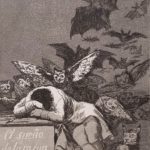
EN version pdf: The issue of symbolism, on the roots of Modern art.
Il y a quelque chose de pourri dans le royaume de l’Art. Cependant, si parfois un débat s’instaure, c’est généralement pour de très mauvaises raisons. Car c’est seulement quand un pays contemple ces déficits budgétaires que parfois des voix se lèvent pour interpeller l’opinion publique avec une question évitée d’habitude : peut-on continuer à alimenter à tout va avec l’argent du contribuable la « création artistique », ou ce qui s’autoproclame telle, sans aucune exigence et hors de tout critère esthétique ?
La peinture en cette fin de siècle se porte mal. A qui aime la patrie des tableaux ne restera bientôt que l’enclos des musées, comme à qui aime la nature ne restent que les réserves des parcs, pour y cultiver la nostalgie de ce qui n’est plus.
(Jean Clair, diplômé d’Harvard, directeur du musée Picasso et du centenaire de la Biennale d’art contemporain de Venise en 1995.)
Introduction
Il y a quelque chose de pourri dans le royaume de l’Art. Cependant, si parfois un débat s’instaure, c’est généralement pour de très mauvaises raisons. Car c’est seulement quand un pays contemple ces déficits budgétaires que parfois des voix se lèvent pour interpeller l’opinion publique avec une question évitée d’habitude : peut-on continuer à alimenter à tout va avec l’argent du contribuable la « création artistique », ou ce qui s’autoproclame telle, sans aucune exigence et hors de tout critère esthétique ?
Abusivement légitimée par son statut de « victime » des régimes hitlérien, stalinien ou maoïste, sa valeur d’acte de résistance politique face aux systèmes totalitaires s’est dissipée avec leur effondrement. Sans vouloir couper les subventions aux jeunes créateurs, ce qui étoufferait l’art dans l’œuf, on est en droit de s’interroger sur l’état des Beaux-arts et leur avenir.
Comme d’habitude chez nous, tout véritable débat tourne rapidement à l’hystérie.
Ainsi, tout soupçon, toute critique, voire même un simple doute sur la valeur de l’art contemporain, formulé par des auteurs aussi « autorisés » que le chroniqueur de « gauche », Jean Baudrillard, le peintre moderne Ben, et même le directeur du Musée Picasso, Jean Clair, sont reçus par une contre-attaque au vitriol de l’ensemble de la « Nomencultura ».
Ainsi, Art Press, Le Monde, Libération ou les Inrockuptibles les ont accusés de travailler pour le camp de la réaction politique, ou de l’obscurantisme philosophique, et par rapprochements successifs, pour celui du fascisme, voire du nazisme ou de l’antisémitisme. Des observateurs remarquent que ces accusations d’une violence déconcertante, rappellent, par leur simplisme, la pire rhétorique stalinienne : « Toute personne qui discute la révolution est un fasciste… » Le journaliste François de Closets fut même qualifié de « complice de Vichy » par Pierre Boulez pour avoir émis un doute sur l’utilité des ordinateurs de l’IRCAM (Institut de Recherche et Coordination Acoustique/Musique) !
Le débat ressemble fort à un dialogue de sourds, surtout quand il se déroule sur fond de « touche pas à ma subvention ». De plus, il faut se souvenir que Jean Clair exposa déjà il y a quatorze ans le fond de sa réflexion dans son livreConsidérations sur l’état des Beaux-arts — Critique de la modernité sans provoquer tout ce déchaînement de passions. Comme quoi les questions de fonds l’emportent sur les questions de fond… En tout cas il faut saluer son courage. Sa critique acide et ironique du snobisme qui habite le petit monde incestueux de l’art contemporain est sans compromis. Sa défense du « métier » dans l’art du dessin et du pastel part d’un juste constat. Il y condamne courageusement l’Art contemporain comme « non-sens devenu système », pour réclamer un « retour au sens », qu’il voit lui… dans l’Art moderne.
Le fond du problème
Donc, si je comprends bien, vous prétendez qu’il existe des critères universels permettant de distinguer le beau du laid et que l’art n’est pas tributaire des caprices du goût… Eh oui ! Bien qu’il n’existe évidemment pas de catalogue rempli d’instructions précises et applicables jusqu’à la fin des temps, nous pensons qu’il existe une démarche et une méthode féconde, utilisées pour la grotte Chauvet jusqu’à nos jours.
Autrement dit, il n’existe pas d’esthétique des formes, mais une esthétique de 1’âme. Toute tentative pour définir l’esthétique comme la science formelle des formes visibles (la linguistique serait alors la science de la poésie) est le chemin le plus court pour entrer dans un cul de sac stérile et académique. Léonard de Vinci définissait ainsi la mission du peintre : il doit « rendre visible l’invisible ». Il faut donc chercher à circonscrire une esthétique de l’invisible et savoir comment il se manifeste dans le visible.
Comment représenter le monde
Nous présentons ici quelques idées personnelles sur la palette des possibilités concernant la représentation des phénomènes, en partant du « plus simple ».
- Les « objets finis » inorganiques ou organiques, (exemples : une pierre, une bouteille, mais aussi une plante, le corps d’un animal ou d’un être humain. Leur relative finitude facilite la possibilité de les représenter. Mais pour les rendre vivants, c’est leur participation à quelque chose d’infini qu’il faut montrer : les variations infinies de la couleur d’une pierre ; les reflets infinis de la lumière réfléchie par une bouteille, l’infinité relative des feuilles d’un arbre, l’infinité des gestes successifs que dictent l’esprit et la vie aux corps des êtres vivants. Déjà, ces choses prétendues « simples » nous forcent à choisir, au-delà de la simple perception, les perceptions permettant d’en exprimer l’idée.
- Les « objets ouvertement infinis » (exemples : une vague sur l’océan, une forêt, des nuages, le regard d’un être humain). Encore plus que dans A, le principe chinois du « li » s’applique. Au lieu d’imiter l’extériorité d’une chose, il faut la voir comme simple expression de l’idée qui en fut le principe générateur et choisir des éléments dans le visuel afin de dévoiler cette réalité. C’est la différence entre le portrait d’un être humain et le portrait d’une statue de cire…
- Des « idées détachées de tout objet » (exemples : l’amour, la justice, la fidélité, la paresse, le froid, …) Comment s’y prendre, comment trouver des éléments établissant des passerelles avec le visible ?
Traçons quelques pistes :
- Je peux, à la place de l’idée, représenter la chose qui est l’objet de l’idée. Par exemple j’essaie de représenter l’amour par une femme. Pourtant, elle est seulement le sujet ou l’objet de l’amour (Elle aime ou est aimée), mais elle n’est nullement l’amour.
- Puisque dans le domaine du visible j’ai du mal à représenter une idée du type idée supérieure, je choisis de la désigner par un symbole. Par exemple un petit cœur (ou une femme), pour l’amour. Pour un martien arrivant sur Terre, le petit cœur ne signifie rien. Par déduction logique, il pourrait même croire qu’il s’agit d’un moyen de désigner les malades cardiaques… ou les cardiologues… ou les victimes d’un culte Aztèque. Pour qu’il comprenne, quelque terrien doit l’initier au sens de ce symbole convenu entre terriens.
- Ce symbolisme peut s’étendre à une petite histoire allégorique. Illustrer une scène de cette allégorie restera un exercice didactique totalement inférieure au caractère sublime de l’œuvre d’art.
- La notion de parabole, telle qu’on la trouve dans la bible, nous rapproche de la solution recherchée, par son caractère métaphorique (en grec meta-poros : ce qui porte au-delà). La présence isochrone de plusieurs paradoxes, provoquant surprise et ironie par les ambiguïtés du tableau, bouscule les certitudes de nos perceptions empiriques qui obscurcissent tant notre prédisposition naturelle à concevoir le beau.
Prenons l’exemple du tableau de Rembrandt van Rijn, Saskia en Flore (1641), où celle-ci offre une fleur au spectateur.
S’agit-il d’un portrait de la femme de Rembrandt à laquelle se juxtapose la représentation d’une fleur ? Ou s’agit-il d’un nouveau concept naissant dans notre esprit comme résultat de cette juxtaposition, et que l’on pourrait nommer « amour » ou « fidélité » (J’offre mon cœur, telle une fleur, à toi pour toujours…). L’analogie de deux choses très différentes en fait ainsi apparaître une troisième : le véritable sujet.
Au niveau le plus simple, le paradoxe métaphorique peut être vu à l’œuvre, et identifié, dans un jeu de mots ou une caricature. Par exemple si je dessine un couple de jeunes amoureux et que je remplace la tête du jeune homme par une tête de chien, un tout autre sens est donné à l’image.
Le spectateur, ravi par l’idée des amoureux, est surpris par le caractère un peu possessif, ou au contraire domestiqué, que leur état peut engendrer… Les nuances viendront avec le type de race de chien et son expression pour faire figure d’amoureux. Une fois de plus, c’est par analogie implicite qu’un sens inattendu nous fait découvrir une idée extérieure à la chose représentée.
La petite lumière qui nous illumine intérieurement lors de la résolution d’un paradoxe métaphorique nous procure alors un triple bonheur. D’abord la joie de penser, car le processus de la pensée est fondé sur ce même processus. Ensuite celui d’être en harmonie avec notre monde, lui-même processus de création, qui nous condamne à être libre. Et enfin le bonheur qui découlera du partage de la joie de notre découverte avec les autres humains qui deviendront encore plus créatifs à leur tour. Chaque découverte scientifique ou artistique devient un rayon de lumière qui éclaire toute l’humanité. Les braises d’hier nous donnent aujourd’hui le feu pour éclairer demain…
Mais pour cela, on ne peut pas simplement présenter la solution trouvée d’une façon formelle. Nous sommes obligés de recréer le contexte qui force, de façon légitime, le spectateur à refaire le cheminement de l’artiste jusqu’au point où il découvre le concept poétique par lui-même et en toute liberté.
Léonard de Vinci était un spécialiste de ce genre d’énigmes. Arrêtons-nous un moment sur Saint Jean-Baptiste (1513-1516 – Louvre), son dernier tableau et véritable testament résumant son approche.
Le caractère ambigu du personnage à souvent servi de « preuve » pour la prétendue homosexualité de Léonard, car on peut effectivement se demander s’il s’agit d’un homme ou d’une femme. Les bras musclés plaident pour le masculin, le visage fin pour le féminin. S’agit-il d’un ange ou d’un diable ? Un doigt pointe vers le ciel (comme Platon, tel que le représente Raphaël dans l’Ecole d’Athènes, avec la tête de Léonard…), l’autre main est sur le cœur. La bouche exprime la coquetterie, les yeux l’intelligence. Bien sûr, Jean-Baptiste semble avoir servi de symbole pour un courant de l’humanisme qui se réclame de Platon et voit le classicisme grec comme annonciateur de l’humanisme chrétien. Au contraire, à l’époque un courant pseudo-catholique prétend que toute personne ayant vécu avant le Christ est forcément condamnée. C’est pourtant le cas de Jean-Baptiste…
La méthode compositionnelle n’a pas ici de caractère symboliste, mais bien celui du paradoxe métaphorique, c’est-à-dire construit par des énigmes qui nous engagent, si nous acceptons ce défi, à réfléchir philosophiquement sur la nature humaine : comment est-il possible d’être fini et infini, esprit et matière, divin et humain, etc. ? Voilà en quelques lignes un résumé de ce que nous entendons par « méthode du paradoxe métaphorique », seule approche méritant réellement le label « classique », car conçue universellement pour toute l’humanité dans le temps de tous les temps.
A l’opposé de cette démarche se trouve la pensée symboliste, officiellement désignée comme le courant artistique dominant, fin du XIXème siècle. De pair avec un impressionnisme imprégné de positivisme, le symbolisme engendra l’art moderne et son enfant bâtard, l’art contemporain. La « symbolisation » érigée en méthode d’expression artistique, est la célébration du non-changement caractéristique d’une société qui choisit de bannir le mouvement du progrès en lui substituant des images ou des choses, dont l’éventuelle multiplication masque le caractère toujours « égal à lui-même ».
Le symbolisme n’est que la transformation en objet d’une émotion forte ou d’une pensée mystique. La mise en valeur de cet objet, à travers l’incantation, le fétichisme, la répétition, etc. où l’on agite le symbole pour sa valeur magique en soi, évoque une fixation obsessionnelle, identique à la pornographie.
Comme le disait un jour l’économiste et philosophe américain Lyndon LaRouche : « la différence entre Beethoven (métaphore) et Wagner (symbole) se situe au niveau des sentiments provoqués dans l’auditoire. Chez Beethoven, l’évocation du beau nous fait repartir avec les larmes aux yeux ; dans le cas du symboliste Wagner, ce sont les chaises qui sont mouillées. »
Oppositions entre symbole et métaphore
Symbole : ce qui désigne une chose ;
Métaphore : ce qui porte au-delà de la chose ;
Symbole : ce qui n’a de valeur que par ce qu’il exprime ;
Métaphore : qui n’a qu’un sens, que nous lui attribuons par analogie implicite ;
Symbole : ce que l’on apprend que par convention ;
Métaphore : ce que l’on découvre par sa propre cognition.
A partir de là, et nous allons le documenter citations à l’appui, l’Art « moderne » s’avère l’extension linéaire et simple transposition d’un symbolisme figuratif en symbolisme abstrait.
Ces termes ne veulent évidemment rien dire car toute figuration est figurative par définition, et toute figuration est précédée d’une abstraction, d’un concept ou d’une idée, fût-elle consciente ou inconsciente.
Ainsi, contrairement à l’art contemporain qui érige le non-sens en système, l’art moderne n’est pas dépourvu de sens, mais il est mystico-symbolique et fortement imbibé d’hermétisme. Il ne s’agit évidemment pas d’exclure toute utilisation de symboles dans la peinture, mais la pensée symboliste en tant que démarche est incompatible avec la notion du sublime dans l’art, car le sublime résulte d’une liberté, et non d’un enfermement dans le secret des symboles.
Le contemporain, lui, comme toute escroquerie de grande ampleur, doit faire appel à la rhétorique et à la littérature pour convaincre son public de sa relativité absolue.
On nous dit ainsi que chacun possède un ensemble de critères tellement différents, que vouloir juger est déjà, par définition, le germe d’un acte totalitaire et fascisant. C’est un peu comme le voleur qui vous accuse de cupidité et de manque d’altruisme parce que vous refusez de lui remettre votre portefeuille… Il est clair que, dès que l’on revendique le droit au non-sens, on revendique pareillement le droit à la non-critique, parce que nous sommes arrivés dans l’univers de « chacun sa secte ». Cet art, quand il est sincère, revendique son imperméabilité à la compréhension humaine et se définit ainsi comme asocial et égoïste. Il ne récoltera que ce qu’il sème : l’indifférence.
Avant de regarder de près deux figures reconnues comme les parrains de l’Art moderne, Wassily Kandinsky et Piet Mondrian, nous avons voulu situer l’environnement qui les influença. Ce contexte est d’abord historique et économique. Ensuite nous enquêterons sur une opération politique de haut niveau : la Société Théosophique dont les thèses délirantes et maléfiques marquèrent profondément nos deux parrains de l’art moderne.
Le symbolisme, stade final du romantisme
Pour anéantir l’élan républicain et scientifique émergeant à la fin du XVIIIème siècle, avec les révolutions américaine et française, l’oligarchie européenne s’accommode, dans un premier temps, de la folie dévastatrice de Napoléon Bonaparte. Dans un second temps, elle promeut, sur les ruines de l’épopée napoléonienne, le corset de fer d’une Sainte-Alliance politique et l’idéologie impuissante du regret : le privilège du cœur souffrant. Le romantisme, décrit comme « un mouvement de libération du Moi, par réaction contre la régularité classique et le rationalisme des siècles précédents », devient ainsi la culture officielle de la Restauration avant d’être récupéré par la Monarchie de juillet.
Même le talentueux Charles Baudelaire, prisonnier de l’air du temps, clame : « Quoi de plus absurde que le progrès », ou de façon prémonitoire : « Qui dit romantisme, dit art moderne, c’est-à-dire intimité, spiritualité, couleur, aspiration vers l’infini ». Ainsi s’exprime une certaine révolte contre le matérialisme scientiste qu’on tente d’imposer par le haut et pour lequel le cœur des hommes n’a pas été sollicité. Nous sommes très loin de l’élan républicain et de l’esprit de la science pour tous qu’anima Gaspard Monge à l’Ecole Polytechnique ou de l’Ode à l’enthousiasmede Lazare Carnot.
Cette même Sainte Alliance a forcé Carnot à l’exil et écarté toute influence de Monge sur l’Ecole Polytechnique en brisant l’élan de la science, et donc de l’industrialisation, en France. En 1871, Louis Pasteur, analysant les raisons de la défaite de la France en 1870 dans son magnifique articlePourquoi la France n’a pas trouvé d’homme supérieur au moment du péril, souligne le caractère tragique de cette erreur.
L’Allemagne vit, elle aussi, sous une véritable dictature culturelle. Le Prince Metternich fait interdire les représentations théâtrales du grand poète et dramaturge Friedrich Schiller par les décrets de Carlsbad. De même, le « sulfureux » poète Heinrich Heine qui se moque avec une fine ironie des Salons de Mme de Staël et de tous les chantres du retour au passé, est un homme traqué par toutes les polices de la Sainte-Alliance. Francisco Goya, qui dénonçe les atrocités commises par les troupes françaises en Espagne (1810-1814), dans sa série Les désastres de la guerre, capte bien la folie de cette époque dans son eau-forte, Le sommeil de la raison engendre des monstres.
Le Grand Chambardement
Au niveau économique, ce n’est qu’après la victoire du président américain Abraham Lincoln sur les confédérés du sud et esclavagistes pro-britanniques, et la formidable épopée industrielle qui s’ensuivit (1861-1876), qu’un certain degré de développement fût toléré en Europe. L’oligarchie devait résoudre le paradoxe suivant : comment continuer à faire le poids face au géant américain naissant, sans que naissent des républiques semblables à l’Amérique sur les ruines des empires européens.
Ce que certains ont appelé « le grand chambardement », fut une transformation profonde et sans pareil de la vie quotidienne des citoyens européens. C’est à cette époque, entre 1850 et 1900 que s’imposa en Europe le courant symboliste. Dans le polygone industriel de « l’Europe de la vapeur » que l’on peut tracer sur une carte en reliant Glasgow, Stockholm, Gdansk, Lodz, Trieste, Florence et Barcelone, on estime que sur sept personnes nées à la campagne, une seule y demeura, une immigra vers le Nouveau monde ou vers les colonies, tandis que cinq partirent vivre dans les villes. Ainsi, on estime que, pour cette période, plus de cinquante millions de personnes quittèrent l’Europe. On peut bien imaginer le « choc culturel » provoqué par l’abandon du monde méfiant et superstitieux de l’arriération rurale.
Le symbolisme est donc aussi, face à cette transformation profonde, une impulsion donnée par l’oligarchie financière, britannique en particulier, dans le but de sauvegarder ses privilèges en maintenant le plus grand nombre dans l’irrationnel. Cette crainte d’une émergence d’Etats-nations voués au progrès scientifique et technologique, non soumis à la logique des empires, amène le Premier ministre britannique Lord Palmerston à lancer les réseaux de laJeune Europe de Giuseppe Mazzini, regroupant les révolutionnaires nationalistes sous son contrôle. Sous l’égide de l’Arab Bureau du Foreign Office britannique, l’Orient voit la naissance de toute une série de « pays » arabes, souvent localisés, comme par hasard, sur des champs pétroliers.
La Société Théosophique
Helena Blavatsky
C’est dans ce contexte qu’il faut situer l’offensive extraordinaire de la Société Théosophique (ST), une pseudo-religion parmi d’autres qui pullulent dans le vaste marais d’ésotérisme pendant la deuxième moitié du XIXème siècle. Il est utile de se pencher sur l’histoire d’Helena Petrowna Blavatsky (HPB), figure emblématique de la ST.
Il faut avouer que le personnage n’est pas dénué d’audace. Fille du colonel Hahn et petite-fille du lieutenant général prussien Alexis von Rottenstern-Hahn, HPB naît en Ukraine en 1831. A l’âge de seize ans, ses parents la marient à un vieux général du nom de Nicéphore Blavatsky, vice-gouverneur de la province d’Erivan, dont elle se sépare aussitôt. En 1848, elle rencontre un copte ou chaldéen nommé Paulos Metamon. Dès 1851, on la retrouve à Londres, où elle fréquente les milieux « spirites » et se lie avec le « révolutionnaire » Mazzini. En 1856, elle s’affilie à l’association Carbonariste de la Jeune Europe.
Dès lors, elle voyage sur tous les continents, devenue un jouet entre les mains de ses promoteurs britanniques, qu’elle désigne comme ses « maîtres spirituels », tel « maître Morya », qui est en réalité une sorte d’agent de liaison. Dès 1851, elle se rend aux Etats-Unis, où elle voyage de la Nouvelle Orléans vers le Mexique en traversant le Texas. Après d’innombrables voyages dans le Caucase, en Syrie et au Liban, elle apparaît en Italie le 3 novembre 1867 aux côtés des Garibaldiens. Lors de la bataille de Mentana, elle est cinq fois blessée et laissée pour morte. Elle se rétablit à Paris et entre en contact avec un journaliste nommé Michal, ainsi qu’avec le fondateur du spiritisme français Allan Kardec. Ces derniers se vanteront d’avoir développé les « facultés médiumniques » d’HPB.
Déployée comme médium au Caire, elle y fut accusée de fraude, ainsi qu’en Amérique où elle se livre à la même activité. Il faut, dans ce contexte, situer l’œuvre littéraire d’Edgar Allan Poe comme un élément très actif de la faction patriotique américaine dans la guerre psychologique contre l’offensive ésotérique des britanniques.
Le colonel Henry Steel Olcott
Vers 1874, elle reçoit l’ordre d’entrer en contact aux Etats-Unis avec un homme de loi, expert en assurances : Henry Steel Olcott, ancien de la police militaire, il fut nommé colonel pendant la guerre de Sécession et partagea ses loisirs entre les loges maçonniques et le spiritisme. Actif comme journaliste, il assurait la couverture des phénomènes paranormaux pour le New York Sun et le New York Graphic. Olcott était fort bien introduit dans tout le milieu ésotérique américain : John King, William Stainton Moses, Leadbeater, le Miracle Club de Philadelphie et une société secrète : l’Hermetic Brotherhood of Luxor, dont les membres signaient déjà leurs écrits avec un svastika, ou croix gammée, symbole de divinité au Tibet, cet immense plateau montagneux qui aurait servi de refuge à l’ancienne race des Aryens lors du déluge…
Ainsi, le 20 octobre 1875 se crée à New York une société « d’investigations spiritualistes ». Le président en est Olcott ; les deux vice-présidents Felt et Pancoast, Mme Blavatsky y occupe la fonction de simple secrétaire. Sans vouloir diminuer son rôle personnel, il semble que HPB n’était qu’une propagandiste au service du renseignement britannique. Parmi les membres, citons William Q. Judge et Charles Sotheran, hauts dignitaires de la maçonnerie anglo-américaine.
On sait aussi qu’à cette époque le général (sudiste) Albert Pike, futur cofondateur du Ku Klux Klan et grand maître du Rite écossais pour la juridiction méridionale, dont le siège est à Charleston, fréquente Mme Blavatsky, mais leur relation ne dure guère. La réputation de Pike semble surfaite et on l’accuse d’avoir généreusement plagié l’occultiste français Eliphas Lévi.
A peine un mois plus tard, le 17 novembre 1875, la société prend le nom de Société Théosophique. Olcott et HPB se lancent immédiatement dans un grand projet pour le « contrôle des esprits » de l’Inde. Officiellement, il s’agit d’établir « le grand contact » entre les initiés d’Orient et d’Occident et de parvenir à leur fusion.
Sans difficulté, HPB se fait attribuer la nationalité américaine et Olcott obtient du président des Etats-Unis, Rutherford Hayes, un ordre de mission manuscrit demandant aux diplomates américains du monde entier de l’aider. Le secrétaire d’Etat lui fournit un passeport diplomatique, chose assez rare à l’époque pour un non diplomate de carrière. Arrivés aux Indes, ils y établissent la British Theosophical Society.
L’oligarchie britannique avait de toute évidence choisi l’hindouisme, avec sa grande tolérance vis-à-vis du système des castes où chacun ne fait qu’espérer une condition meilleure dans une vie ultérieure, comme un partenaire préférentiel car compatible avec la société de classes de l’aristocratie anglaise et son dessein impérial. Ce choix d’une matrice culturelle définie par des croyances a toujours guidé l’intérêt à long terme de l’oligarchie, outrepassant telle ou telle structure ou régime. Il ne s’agit pas de contrôler ce que les gens pensent, mais la façon dont ils formulent une pensée sur n’importe quel sujet. Ce que raconte aujourd’hui la ST sur son rôle émancipateur dans la « prise de conscience nationale » aux Indes n’est que pure fabulation, car sans elle l’Inde aurait pu être indépendante un siècle plus tôt ! Il est néanmoins vrai que Gandhi, entré en contact avec la ST dans un club végétarien de Londres, s’est penché sur leurs écrits sans pour autant jamais y souscrire.
Après la fondation de la ST en Inde, Olcott, toujours au service du même dessein, se consacre à fond au bouddhisme, parcourant l’Asie jusqu’au Japon pour réveiller les « foules endormies ». Il rédige un catéchisme bouddhiste et crée leur étendard multicolore, de même qu’un comité général des Affaires bouddhiques, véritable Vatican asiatique. Il tient une conférence extraordinaire à Hiroshima, centre militaire du japon. Il fait distribuer des svastikas à ses auditeurs auxquels il prédit que des guerres épouvantables s’abattront sur l’humanité. Il affirme cependant qu’Hiroshima deviendra l’un des symboles de paix et de fraternité qui régneront un jour sur le monde.
Balayer le Christianisme de la terre
Olcott et HPB se livrent en permanence à des tours de magie tout-à-fait amusants. Mme de Jelihowsky résume ainsi les phénomènes produits par HPB durant son séjour à Pskoff :
- Réponses directes et claires, du genre télépathiques.
- Formules données en latin, au moyen de coups, pour des remèdes assurant toujours une guérison.
- Divulgations en public de secrets concernant des personnes présentées ayant émis des doutes de façon blessante.
- Changement de poids de meubles, ou de personnes, à volonté.
- Lettres écrites par des correspondants inconnus avec une écriture qui n’était pas celle de Mme Blavatsky. Souvent, on posait une question et elle répondait : « Allez dans votre chambre, vous trouverez à tel endroit, dans une lettre, la réponse à votre question. »
- Apparition et disparition d’objets sans que l’on puisse donner d’explication plausible au prodige.
- Faculté de faire entendre des sons musicaux n’importe où et quand elle le désirait.
Dans ses moments de grande déprime, HPB avoue avoir escroqué ses admirateurs. Ainsi, Olcott écrit dans le Lotus Bleu, du 27 novembre 1895, p.418 :Certains jours, elle se trouvait dans des dispositions telles qu’elle se prenait à nier les pouvoirs dont elle nous avait donné le plus de preuves soigneusement contrôlées par nous ; elle prétendait alors qu’elle avait trompé son public.
Derrière ces tours de passe-passe, réservés aux membres crédules de la ST, se trouve une petite élite « d’initiés », au courant du véritable projet de destruction que représentait la ST. « Notre but, déclare HPB, n’est pas de restaurer l’hindouisme, mais de balayer le Christianisme de la terre ».
Après la première crémation de l’histoire des Etats-Unis (celle du baron de Palm, un bienfaiteur de la ST, à laquelle s’opposent pas moins de trois mille personnes) dont le but est de faire connaître l’hindouisme, Olcott et HPB développent confusément leur doctrine en 1878 dans ce que HBP appela « l’œuvre de sa vie » :Isis dévoilée (1300 pages) et, sous une forme plus condensée, dans la Doctrine Secrète. D’un point de vue théosophique, et dans un retour au pur manichéisme, on peut classer les religions en croyances mâles et femelles . Les unes accordent la prépondérance à la paix, la tranquillité, la sensualité, la fécondité, l’adaptation au milieu ; les autres flattent l’esprit de conquête et d’entreprise, le prosélytisme, la supériorité des vertus mâles. Evidemment, Abraham et Moïse, fondateurs des grandes religions monothéistes où l’homme ne s’adapte pas, mais intervient et trouve même son harmonie spécifique en transformant la nature pour hausser l’ordre de l’univers, furent désignés comme les bêtes à abattre. Ce sont effectivement eux qui mirent fin au culte de la déesse Mère, devenu culte d’Isis.
Le culte d’Isis
Isis ailée
Isis est la plus illustre des déesses égyptiennes, chargée du foyer, du mariage et de la fécondité. Son pouvoir s’étendra à tout l’univers après sa découverte du nom secret du Dieu suprême, Rê. Elle incarnera le principe féminin, source magique de toute transformation ; et sera considérée par tous les ésotériques comme l’Initiatrice, celle qui détient le secret de la vie, de la mort et de la résurrection. Selon la légende, elle recomposera son mari Osiris que le serpent Set avait découpé en quatorze morceaux et disséminé à travers l’Egypte. Une seule pièce manquait : le pénis. Isis en fabriqua un en argent. De son mariage avec Osiris naîtra Horus qui triomphera dans le combat contre l’esprit du mal, Set, mais Isis lui demandera de l’épargner pour maintenir la bataille cosmique entre le bien et le mal… Souvent désignée par la croix ansée, symbole de millions d’années de vie future, qu’on confond avec le « nœud d’Isis », symbole d’immortalité, Isis est aussi représentée par l’Ouroboros, ou le serpent qui se mord la queue : union sexuelle avec soi-même, autofécondation permanente, il est perpétuelle transformation de mort en vie.
Pour cela, une stratégie machiavélique est mise en place :
- Le culte de la déesse Mère et la pratique des vertus femelles n’existant guère qu’aux Indes et au Tibet, il faut mettre à la mode les religions hindouistes, en leur restituant des valeurs archaïques. D’où la course effrénée des théosophes en Inde pour empêcher la quasi-disparition de l’hindouisme. En France, le principal sponsor de Blavatsky dans cet effort est sans doute la richissime duchesse de Pomar, aristocrate espagnole descendant du marquis anglais de Northampton. Dans ce but, il faut encourager l’orientalisme et la pratique du yoga.
- La ST étant à elle seule trop faible pour s’attaquer avec efficacité aux religions chrétiennes, juives et musulmanes, elle s’engage à fond dans un socialisme Fabien et anti-progrès. Le juste combat pour une laïcité républicaine, fondé sur le respect des grandes religions, est dénaturé dans une virulente dénonciation du christianisme. A l’opposé, Jean Jaurès, tout en critiquant le matérialisme inhérent de l’ultra-capitalisme et du marxisme, au nom d’une certaine idée de la transcendance, défend avec passion un droit « à l’entière croissance » et au progrès matériel de chaque être humain.
- Pour lutter contre la « suprématie mâle », il est nécessaire, par la parole et par l’écrit, de répandre des idées opposées au principe masculin, de défendre la paix universelle, de prôner l’égalité des sexes, de rendre la femme libre de son corps, que l’amour prenne le pas sur la violence… Pour cela les théosophes s’engagent dans le combat féministe et mettent toujours une femme à leur tête. Annie Besant, une belle irlandaise protestante et membre de la Fabian Society, prend la direction de la ST après avoir dirigé en Angleterre la « Ligue malthusienne » en 1877.

Isis (le serpent qui se mord la queue) et la croix gammée figurent toujours dans l’emblème de la Société Théosophique
Pareil projet rencontra évidemment beaucoup d’opposition à l’époque, surtout dans les pays catholiques. Cette opposition se montre tellement forte qu’une version théosophique du « christianisme ésotérique » est élaborée pour pénétrer le monde chrétien. Selon HPB, le monothéisme judéo-chrétien n’est rien d’autre qu’un schisme barbare du bouddhisme :Ce qu’on a dédaigneusement appelé paganisme était l’ancienne sagesse, saturée de divinité ; et le judaïsme avec ses rejetons, le christianisme et l’islamisme ont tiré toute leur inspiration de ce père ethnique…
Pour HPB, Jésus l’Essénien fût persécuté par les Juifs parce que « les Esséniens étaient des convertis, des missionnaires bouddhistes qui, à un moment avaient envahi l’Egypte, la Grèce et même la Judée… » Il faut donc « déjudaïser » le christianisme pour le rendre compatible avec le principe féminin. Le postulat de base de tout ceci est la fascination pour la civilisation aryenne dont l’écriture est le sanscrit et le svastika ou croix gammée, symbole de notoriété macabre qui figure toujours dans le sigle de la ST.
Le svastika ou croix gammée
Le svastika ou croix gammée : Symbole très répandu dans toutes les civilisations anciennes (Asie, Amérique centrale, Mongolie, Inde, Europe du nord, Celtes, Basques, Etrusques, etc.), il représente le tourbillon créationnel. Le svastika, qui remplace souvent la roue, est fait d’une croix dont chaque branche, comme dans des orientations vectorielles qui définissent un sens giratoire puis renvoient vers le centre, se trouve quadruplée. Sa valeur numérique est donc quatre fois quatre = seize. C’est le développement en puissance de la réalité ou de l’Univers, expression d’un pouvoir séculier extrême. Sa récupération par Hitler ne dut rien au hasard.
L’avènement du mouvement Nazi n’est pas étranger à l’activité de la fameuse Société de Thulé, autre société ésotérique de style théosophique, dans laquelle on retrouve Karl Haushofer, le véritable maître à penser d’Adolf Hitler. Les anthroposophes de Rudolf Steiner, grand admirateur de Nietzsche et de l’eugéniste Haeckel, sont une branche dissidente de la Société Théosophique, omniprésente aujourd’hui chez les « Grünen » (Verts) allemands.
Les Nabis
Voilà donc un coin du voile levé sur le contexte historique d’ou émergea l’Art « moderne ». Cette mode ésotérique envahissante pousse les peintres à aller prospecter les religions pré-chrétiennes, pour y extraire des « symbolismes oubliés ». C’est le cas du symboliste français Gustave Moreau, avec le mythe gnostique de Jupiter et Sémélé. Ses élèves sont Henri Matisse, Georges Rouault et Albert Marquet. Un autre jeune symboliste, Emile Bernard inspire Gauguin, qui sert à son tour de modèle spirituel à Paul Sérusier. L’historien d’art Michael Gibson note avec pertinence que la plupart des grandes figures du moderne (Kandinsky, Mondrian, Malevitch, Picasso, etc.) sont tous des symbolistes figuratifs à leurs débuts. Nous sommes convaincus qu’ils le sont restés, mais que les symboles ont été « primitivisées », et réduits à un simple élément constitutif du champ visuel (une couleur, une ligne, une géométrie, un nombre, etc.). Gibson identifie avec beaucoup de flair ce passage au « moderne » avec l’action du groupe des Nabis.
En 1888, près de Pont-Aven en Bretagne, Paul Sérusier peint un jour en présence de Gauguin un paysage en aplats de couleurs vibrantes de pur style primitif sur le couvercle d’une boîte à cigares.
Cette oeuvre est surnommée Le Talisman par ses camarades qui y voient la révélation d’une nouvelle approche à la peinture, destruction absolue de l’idée d’espace physique à travers la perspective ou la lumière. Bienvenue dans l’espace mystique de la couleur avec sa lumière « intérieure ».
Paul Sérusier, Emile Bernard, Paul Gauguin et leur groupe se baptisent les « Nabis », ce qui signifie prophètes en hébreu. Ils se réunissent dans un hôtel particulier qu’ils nomment « le Temple » (à Paris, au 22 boulevard Montparnasse).

La perte du pucelage Paul Gauguin, 1891, The Chrysler Museum, Norfolk, Etats-Unis. Le renard est le symbole de la puissance sexuelle et du renouveau. La fleur coupée dans la main est un autre symbole non moins significatif.
Rien que cette phraséologie évoque à elle seule toute la dimension pseudo-messianique de ces « initiés ». Dès 1892, l’escroc génial Sâr Joséphin Péladan invite tous ces jeunes talents au Salon de la Rose-Croix. Même l’écrivain symboliste Joris-Karl Huysmans, par la bouche d’un personnage de son roman, qualifie Péladan de « Bilboquet du Midi ». « Ces gens sont pour la plupart de vieux feuilletonistes ratés ou de petits jeunes qui cherchent à exploiter le goût d’un public que le positivisme harasse !… » .
Dans les Mandements de la Rose-Croix esthétique, Péladan proscrit la peinture historique, patriotique et militaire, ainsi que « toute représentation de la vie contemporaine, le portrait, les scènes rustiques, les marines, l’orientalisme, les animaux domestiques, les fleurs, les bodégones, les fruits, accessoires » et « autres exercices que les peintres ont d’ordinaire l’insolence d’exposer ». « Par contre, et pour favoriser l’idéal catholique et le mysticisme, l’ordre accueillera toute oeuvre fondée sur la légende, le mythe, l’allégorie, le rêve… »
On voit donc que le catholicisme réduit à un symbolisme, tout autant que ses opposants, baigne dans l’ésotérisme le plus loufoque ; il finit fatalement par bien s’entendre avec eux. On peut se demander pourquoi une Guerre mondiale n’a pas éclaté plus tôt avec pareilles folies !
Ainsi, quand elle éclate en 1914, Jacques Emile Blanche déclare : « Souvent au cours de cette guerre « cubiste », chimique et scientifique, dans les nuits ravagées par les raids aériens, j’ai songé au Sacre du Printemps ».
A Paris, le Salon de Péladan regroupe des peintres symbolistes belges, hollandais, allemands, tels que Ferdinand Hodler, Carlos Swabe, Jan Toorop, Ferdinand Knopff, Jean Delville, Georges Minne et Xavier Mellery, ainsi que les « Nabi » Emile Bernard, Félix Valloton ou Charles Filliger. Tout ceci émane également, en grande partie, d’Angleterre où une révolte éclate contre l’académisme de Sir Joshua Reynolds. Sous les auspices et la protection du très populaire John Ruskin, véritable maniaque nostalgique d’un retour à un ordre féodal et mystique d’avant la Renaissance, apparait la Pré-Raphaelite Brotherhood (PRB) qu’un de ses fondateurs, Dante Gabriel Rossetti nomme avec humour Penis Rather Better.
Du positivisme au mysticisme
Le parcours personnel du peintre Kandinsky, universellement reconnu comme fondateur et parrain de l’Art moderne, nous éclaire encore plus sur cette question. Wassily Kandinsky naît le 4 décembre 1866 à Moscou d’une richissime famille aristocratique orthodoxe ayant fait fortune dans le commerce du thé. Comme Henri Matisse, il entre à l’université pour y étudier le droit et l’économie politique. En 1889, il est chargé d’une mission par la Société impériale des sciences naturelles et d’ethnographie qui consiste à étudier le droit criminel du peuple finnois Syrjaenen, tribu non christianisée établie dans la province de Vologda, à cinq cents kilomètres au nord de Moscou. Kandinsky écrit en 1937 : « A vrai dire, l’origine de ma peinture abstraite serait à chercher chez les peintres religieux des 10ème et 14ème siècles et dans la peinture populaire russe que j’ai vue pour la première fois lors de mon voyage dans le nord de la Russie. »
Nommé professeur de droit en 1896, cette même année un événement lui perturbe gravement l’esprit et il décide d’abandonner sa carrière universitaire, plongeant alors dans une crise mystique : la découverte de la radioactivité par le physicien français Antoine-Henri Becquerel :
« La désintégration de l’atome était la même chose, dans mon âme, que la désintégration du monde entier. Les murs les plus épais s’écroulaient soudain. Tout devenait précaire, instable, mou. Je ne serais pas étonné de voir une pierre fondre en l’air devant moi et devenir invisible. La science me paraissait anéantie : ses bases les plus solides n’étaient qu’un leurre, une erreur de savants qui ne bâtissaient pas leur édifice divin pierre par pierre, d’une main tranquille, dans une lumière transfigurée, mais tâtonnaient dans l’obscurité, au hasard, à la recherche de vérités et dans leur aveuglement, prenaient un objet pour un autre ».
Le passage d’un positivisme « matérialiste » à un mysticisme « spiritualiste » semble avoir trouvé en Kandinsky un exemple clinique. Tombé en admiration devant un opéra de Wagner, qu’il découvre à Moscou, il part habiter à Munich. Selon lui, « Lohengrin, me semble être une parfaite réalisation de Moscou. Les violons, les basses profondes et tout particulièrement les instruments à vent personnifiaient alors pour moi toute la force des heures du crépuscule. »
En 1900, après un premier refus, il est admis, avec Paul Klee, à l’examen d’entrée à l’académie de Franz von Stück, symboliste fort bien coté. Le Baiser du Sphinx (1895) de von Stück élabore le même thème que celui du tableau Jupiter et Sémélé de Gustave Moreau.
Le cavalier bleu terrassant le matérialisme
Un an plus tard, l’élève devient à son tour professeur. Il fonde le groupe Phalanx, symbole de la lutte contre l’académisme. Il s’avère habile organisateur de salons de peinture, disposant d’une fortune personnelle considérable et d’une force de conviction capable de mobiliser d’autres sponsors. Il internationalise très vite son combat, car la présence d’artistes étrangers donne une apparence universelle à la nouvelle tendance et dans la bonne tradition théosophique, il ouvre avec raison son groupe aux femmes jusqu’alors exclues des académies officielles.
Son admiration pour Blavatsky est d’ailleurs sans bornes. « Mme Blavatsky a certainement été la première à établir, après des années de séjour aux Indes, un lien solide entre ces ’sauvages’ et notre culture. A cette époque naquit l’un des plus grands mouvements spirituels unissant aujourd’hui un grand nombre d’hommes, en matérialisant cette union sous forme d’une ’Société Théosophique’. Cette société est composée de loges, qui tentent d’approcher les problèmes de l’esprit par la voie de la connaissance intérieure. »
Unissant le groupe « Die Brücke » à ses propres efforts et à ceux de Franz Marc et Paul Klee, il fait naître l’Almanach du « Cavalier Bleu », en réalité une image retravaillée des icônes byzantins représentant St Georges transposé en chevalier spirituel terrassant le matérialisme.
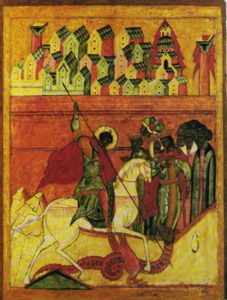
Saint-Georges terrassant le dragon Icone de Novgorod, 16e siècle, collection Dominique de Ménil-Schlumberger, Houston, Texas. Wassily Kandinsky, 1912, couverture du Der Blaue Reiter, Editions Piper, donation Delaunay, Bibliothèque Nationale, Paris.
Dans son texte fondateur de 1909, « Du Spirituel dans l’art et dans la peinture en particulier », Kandinsky construit tout un système magique de la couleur ayant une identité en soi :
« Le rouge tel que l’on se l’imagine, comme couleur sans frontière, typiquement chaude, agit intérieurement comme une couleur très vivante, vive, agitée, qui n’a cependant pas le caractère insouciant du jaune qui se dissipe de tous côtés, mais donne l’effet, malgré toute son énergie et son intensité, de la note puissante d’une force immense presque consciente de son but. Il y a dans cette effervescence et dans cette ardeur, principalement en soi et très peu tournée vers l’extérieur, une sorte de maturité mâle. »
« Lorsqu’il est moyen, comme le cinabre, le rouge gagne en permanence et en sensibilité aiguë : il est comme une passion qui brûle avec régularité, une force sûre d’elle-même, qu’il n’est pas aisé de recouvrir, mais qui se laisse éteindre par le bleu comme le fer rouge par l’eau. Ce rouge ne supporte rien de froid et perd par là sa résonance et sa signification. Ou plus exactement : ce refroidissement brutal, tragique, produit un ton que les peintres, aujourd’hui surtout, évitent et interdisent comme ’sale’. A tort. La saleté, sous sa forme matérielle, représentée matériellement, en tant qu’être matériel, possède sa résonance intérieure d’être matériel comme tout autre être. C’est pourquoi vouloir éviter la saleté en peinture est aussi injuste et aussi arbitraire que la peur d’hier devant la couleur `pure’. Il ne faut pas oublier que tous les moyens qui procèdent de la nécessité intérieure sont purs. Autrement ce qui est extérieurement sale est intérieurement pur. Sinon ce qui est extérieurement pur est intérieurement sale. »
« Les six couleurs, qui, par paires, forment trois grands contrastes, se présentent à nous comme un grand cercle, comme un serpent qui se mord la queue (symbole de l’infini et de l’éternité). Et à la droite et à la gauche nous trouvons les deux grandes possibilités du silence ; celui de la mort et celui de la naissance. »
On voit ici toute la rigueur de la logique formelle qu’un docteur en droit, charmé par le sens de la « construction » du droit romain, applique avec zèle au mysticisme. En plusieurs endroits apparaissent des références à la musique, telles « résonance, harmonie, rythme » etc. De la même façon que les idées musicales ne sont pas seulement communiquées par les paroles du texte, Kandinsky et Klee prétendent, avec ruse et habilité, qu’en peinture la couleur, le rythme, les formes, etc., prises en soi, peuvent communiquer des concepts.
Proche de Kandinsky, on retrouve le compositeur de musique atonale, Arnold Schönberg, qui fera éclater le système musical bien tempéré selon les mêmes principes mystiques, le rendant ainsi incapable de transmettre des idées.
De Piet Mondrian à Arno Breker
Le célèbre cubiste hollandais, Piet Mondrian, est un autre produit original du mélange de théosophie et de rigorisme calviniste. A l’époque, la ST recrute en faisant appel à ceux qui veulent « avoir une place parmi les pionniers de la pensée prochaine ». Une grande photo de Blavatsky décore son atelier de Laren aux Pays Bas, où il fréquente l’écrivain théosophe Schoenmakers, dont il distribue les livres. Dès 1892, il examine les théories de la ST, pour y adhérer en 1909.
Son triptyque « Evolution » exprime les trois stades de l’évolution spirituelle : à gauche, la déesse mère avec des triangles pointés vers le bas (y compris le bout des seins en forme de triangle…), le niveau le plus bas. Au centre, la même figure féminine, mais avec les triangles pointés vers le haut, stade d’activité et d’éveil. A droite, la synthèse des deux, en contemplation, avec les triangles s’entrecroisant en étoile. Nous sommes ici en plein délire théosophique.
Abordons aussi de l’art officiel du 3ème Reich, avec le symbolisme réaliste et religieusement païen du sculpteur Arno Breker, sculpteur personnel et préféré d’Adolf Hitler et réalisateur des fameuses sculptures incarnant l’Übermensch (surhomme) décorant le stade olympique de Berlin en 1936. L’artiste, qui se prétend « apolitique », ne peut ignorer le caractère réel du pouvoir au service duquel il se range. Son Bereitschaft (traduit en français comme La force) de 1939 en est un parfait exemple. Coqueluche des élites parisiennes, accueillant plus de 80.000 visiteurs à Paris en 1942 pour son exposition personnelle à l’Orangerie, il partage l’éthique fasciste de la cinéaste Leni Riefenstahl, toujours au service du régime nazi.
Grand ami de Jean Cocteau, de Vlaminck et de Derain, courtisé par Staline en 1945, son parcours est celui d’un cubiste (en 1922), déçu de sa rencontre avec Paul Klee et le Bauhaus, qui se relance dans la déification du corps humain. « J’ai toujours essayé de représenter le sens par un symbole », dit-il. D’ailleurs Breker n’hésite pas à transposer des têtes d’aigles sur des corps humains, comme dans sa sculpture Jeune Europe (1980), symbole du fils d’Isis, Horus.

Au centre, Arno Breker dans son atelier. A gauche, Le vainqueur, et à droite, Jeune Europe, 1980, Düsseldorf. En tranférant la tête de l’aigle impérial sur le corps athlétique d’un jeune champion olympique de natation, Breker « fabrique » ici un nouveau Horus, fils d’Isis…
Cette inversion des symbolismes, réaffirmant la suprématie des valeurs mâles sur les valeurs femelles, n’est rien d’autre que la création d’une esthétique de la guerre. Celui qui se vante en 1980 d’avoir protégé Pablo Picasso et Dina Vierny, est aujourd’hui admiré par Alain de Benoist et sa « Nouvelle Droite », toujours en quête de mythes fondateurs.
Voyons aussi les futuristes italiens, dont la plupart rejoindront le fascisme. Ils sont d’ailleurs un peu étonnés d’être condamnés avec tant de virulence par Hitler à Nuremberg. F.T. Marinetti, dans le Manifeste du futurisme, publié dans Le Figaro du 20 février 1909, affiche pourtant la couleur :
« (3). La Littérature ayant jusqu’ici magnifié l’immobilité pensive, l’extase et le sommeil, nous voulons exalter le mouvement agressif, l’insomnie fiévreuse, le pas gymnastique, le saut périlleux, la gifle et le coup de poing (…) »
« (7). Il n’y a plus de beauté que dans la lutte. Pas de chefs-d’œuvre sans un caractère agressif. La poésie doit être un assaut violent contre les forces inconnues, pour les sommer de se coucher devant l’homme (…) »
« (9). Nous voulons glorifier la guerre —seule hygiène du monde— le militarisme, le patriotisme, le geste destructeur des anarchistes, les belles Idées qui tuent, et le mépris de la femme.(…) »
« (10). Nous voulons démolir les musées, les bibliothèques, combattre le moralisme, le féminisme et toutes les lâchetés opportunistes et utilitaires…. »
Ainsi, nous avons montré que cette modernité-là n’est rien d’autre qu’une restauration des « valeurs » les plus rétrogrades des civilisations anciennes, vidées de leur fil conducteur de progrès et figées en caricatures de leurs propres défauts. Ce que nous défendons ici est, au contraire, une renaissance, c’est-à-dire la création authentique fécondée par les meilleures contributions de l’ensemble des civilisations, qu’elles soient indiennes, africaines, asiatiques ou européennes.
Notre critique du moderne n’est donc nullement fondée sur la nostalgie passéiste d’un âge d’or supposé parfait, mais sur une certaine dignité de l’homme et de son esprit. Maintenant, si vous voulez parler de modernité, parlons des peintures du Fayoum des 2ème et 3ème siècle.
Quant aux théosophes, bien qu’il existe toujours un réseau mondial de loges Blavatsky, d’Anvers à Philadelphie jusqu’à Saint-Pétersbourg, c’est surtout le courant écolo-pacifiste vert qui incarne cette volonté de destruction du paradigme culturel humaniste.
Comme les théosophes hier, les Verts qui ont remplacé la déesse mère (car ça fait « trop religieux ») en Terre mère (Gaïa), comptent changer la face du monde avec le même messianisme, et s’allient de fait avec les courants du sang, du sol et de la race. Comme hier, ce courant s’est développé sous la protection des plus hautes sphères de l’oligarchie britannique : Feu Jimmy Goldsmith, coffre-fort du vicomte Philippe de Villiers, a un frère, Teddy , qui, lui, est un grand protecteur de Greenpeace ! Aujourd’hui c’est sous le patronage du Prince Philip — mari consort de la reine d’Angleterre Elisabeth II — fondateur et président d’honneur du WWF (Fonds mondial pour la nature), que Greenpeace peut se lancer à l’assaut du nucléaire français, perçu comme le symbole de la société industrielle moderne.
A lire : Les racines fascistes et symbolistes des « killer games ».
Bibliographie
- Chaitkin, Anton et Tarpley, Webster « The Palmerston Zoo », Executive Intelligence Review, Vol. 21, N°16, 15 avril 1994.
- Clair, Jean, « Considérations sur l’Etat des Beaux Arts — Critique de la modernité », Gallimard, Paris 1983, chap. I, p.11.
- Parmelin, Hélène, « Peinture, pierre de touche de la liberté », L’Unité n°416, vers 1978.
- Cheminade, Jacques, « Time to destroy the myth of Napoleon Bonaparte », Executive Intelligence Review, Vol. 23, N°42, oct.18, 1996.
- Gibson, Michaël, « Le symbolisme », Editions Taschen, 1994.
- Jaurès, Jean, « De la réalité du monde sensible », Editions Alcuin, Paris, 1994.
- Kandinsky, Nina, « Kandinsky et moi », Flammarion 1978, Paris, citations de « Regards sur le passé » de Wassily Kandinsky.
- Kandinsky, Wassily, « Du spirituel dans l’art, et dans la peinture en particulier », Editions Denoël, Paris 1989. Ecrit en 1909, paru en 1911, p.76. (en anglais, Dover Editions, New York, 1977).
- Lantier, Jacques « La Théosophie », Editions Culture, Art, Loisirs, p.107.
- LaRouche, Lyndon, « How Cauchy ruined France », Executive Intelligence Review, Vol. 24, N°24, 20 juin 1997.
- Noël, Bernard, « Arno Breker et l’art officiel », Jacques Damase Editeur, Paris 1981.
- Sloan, Christopher and Laurie, « The war against Raphael », New Solidarity, 23 mai 1983.


